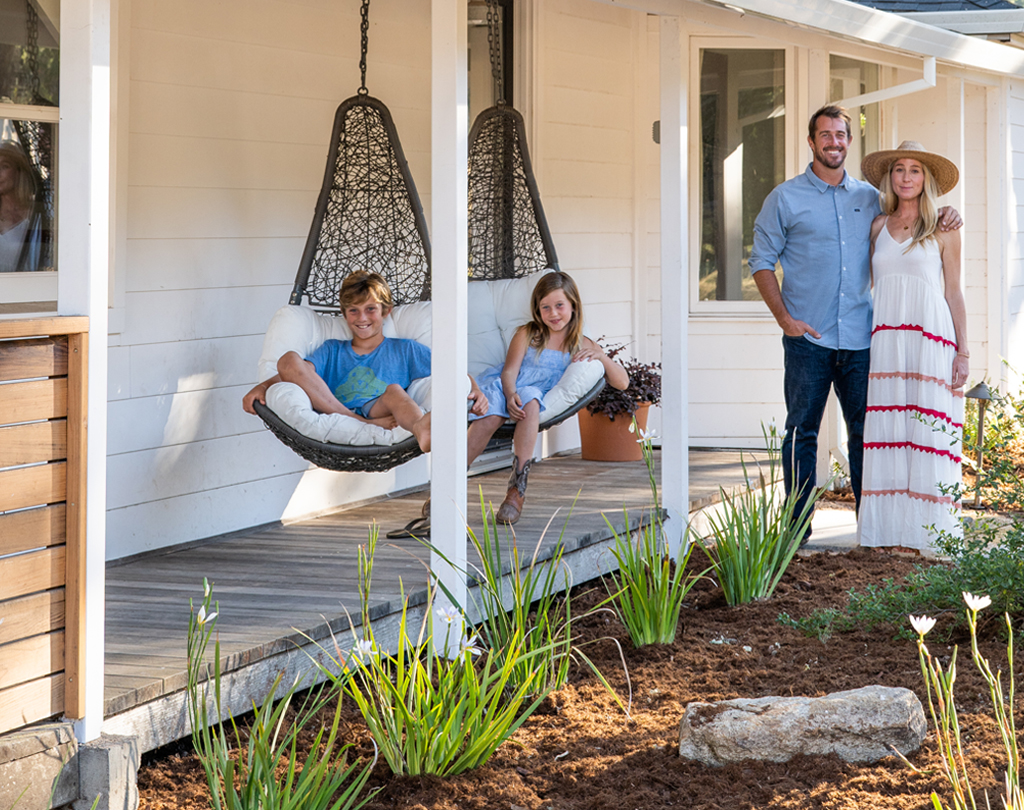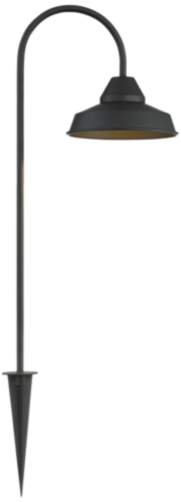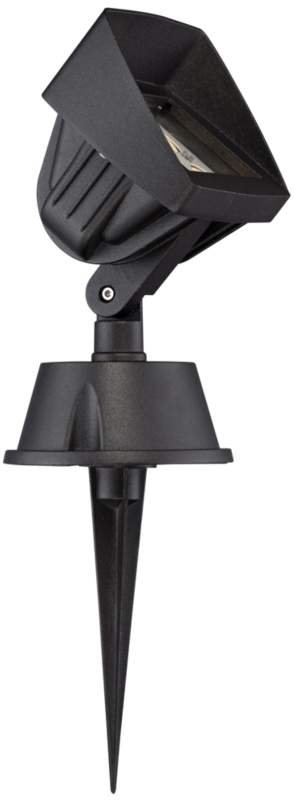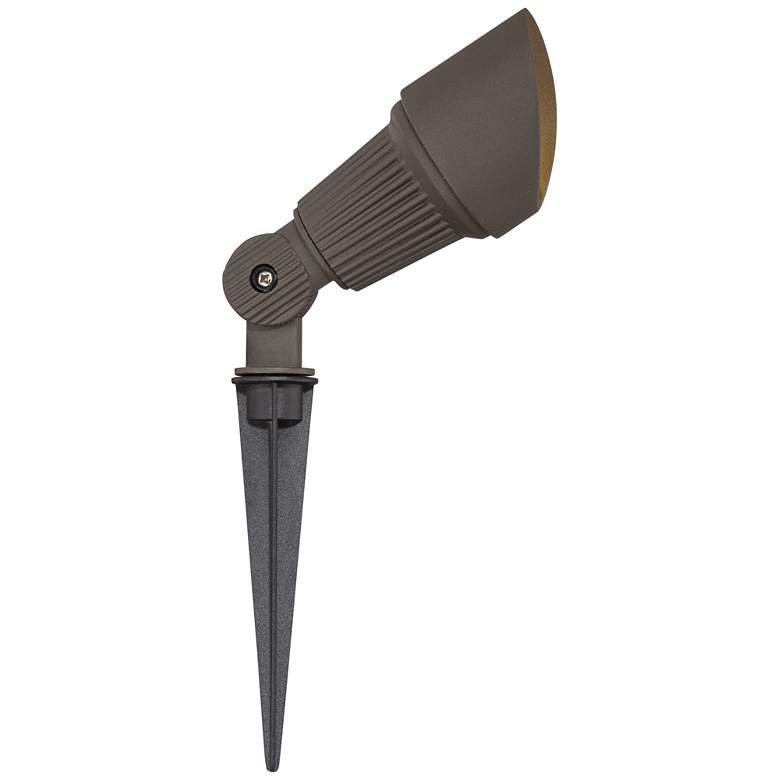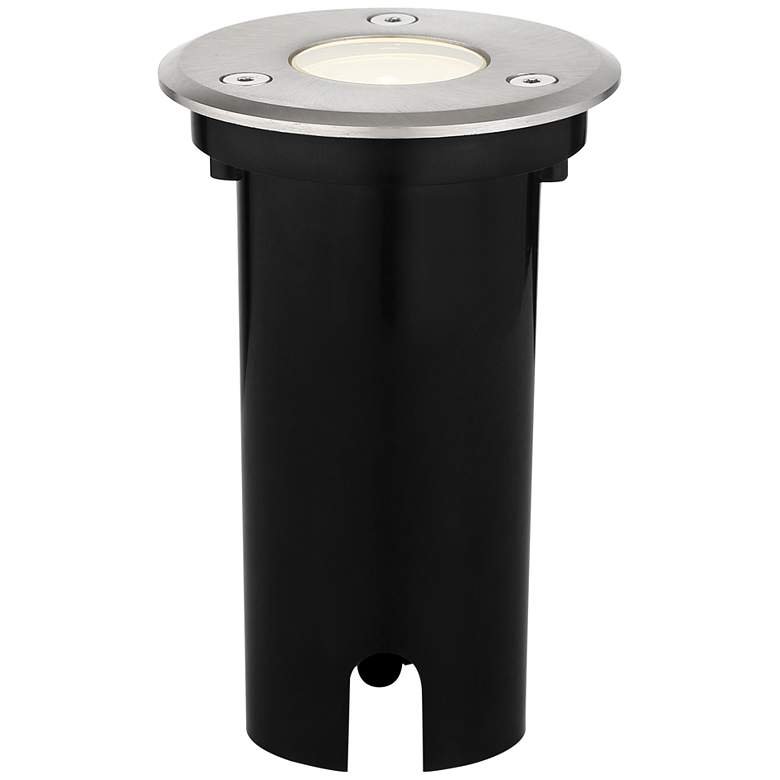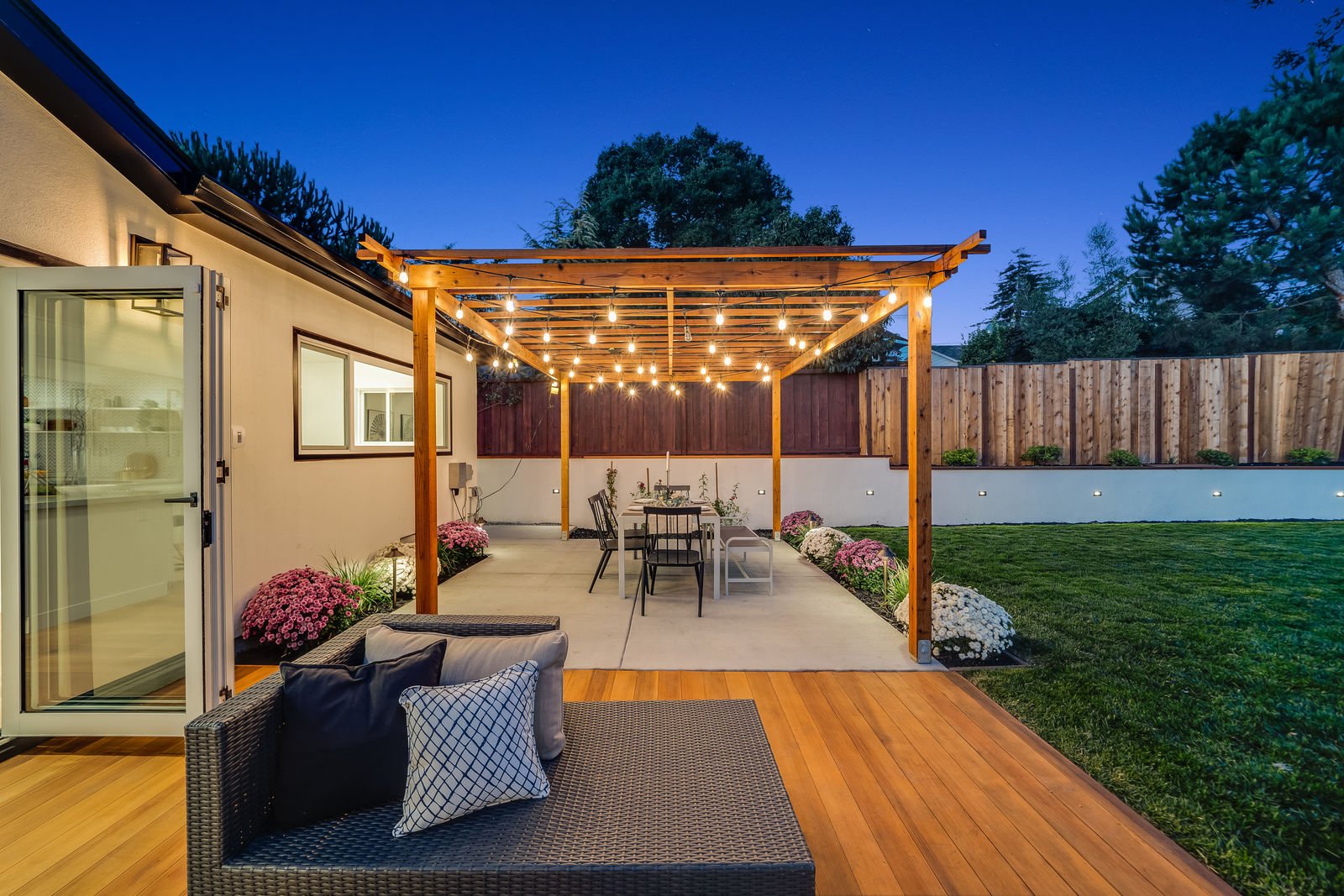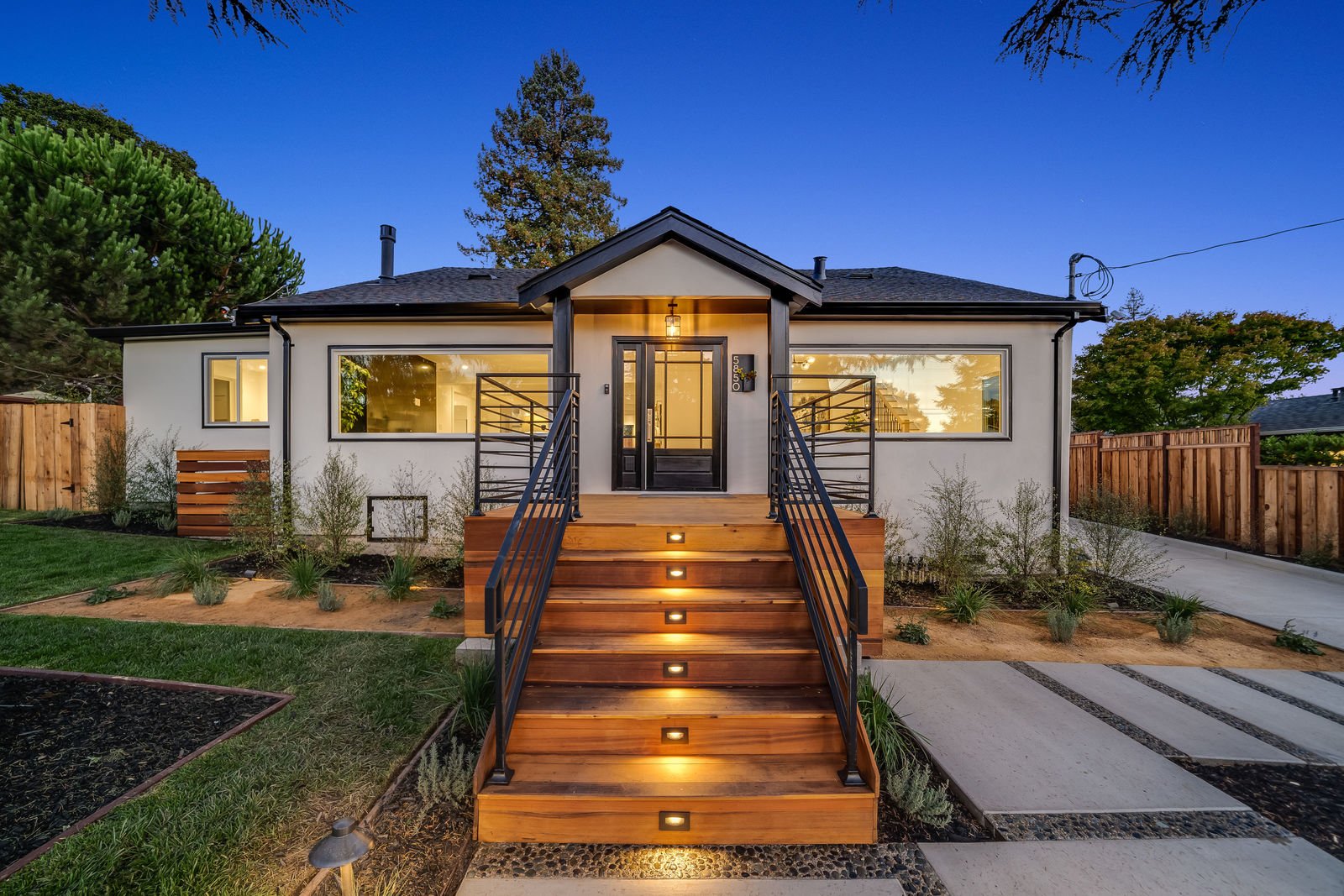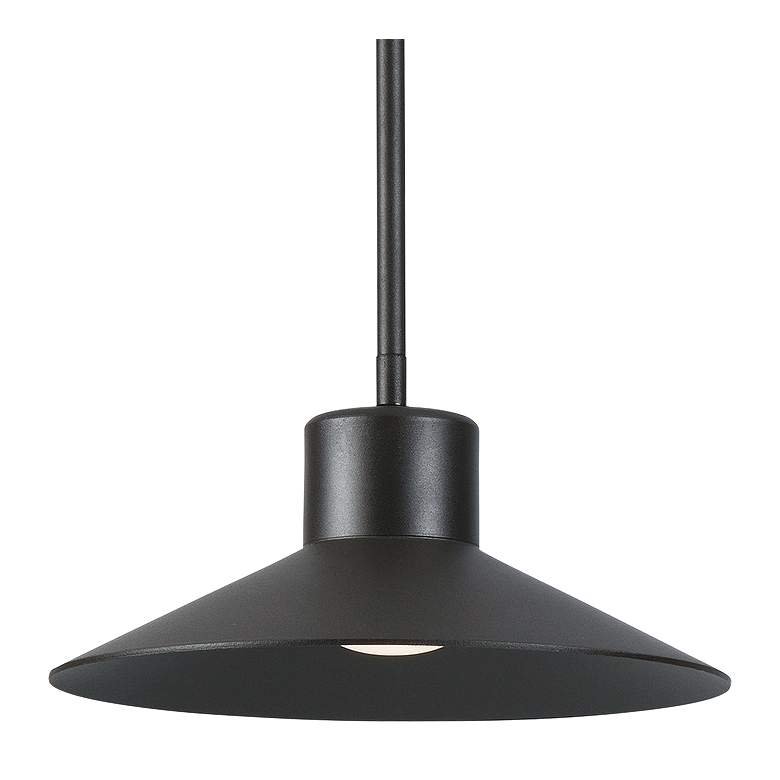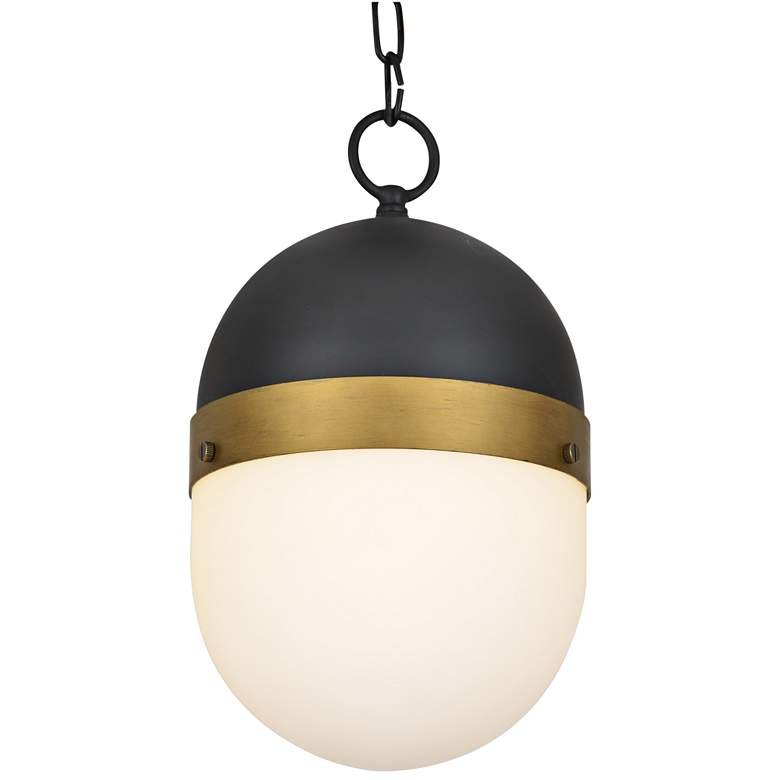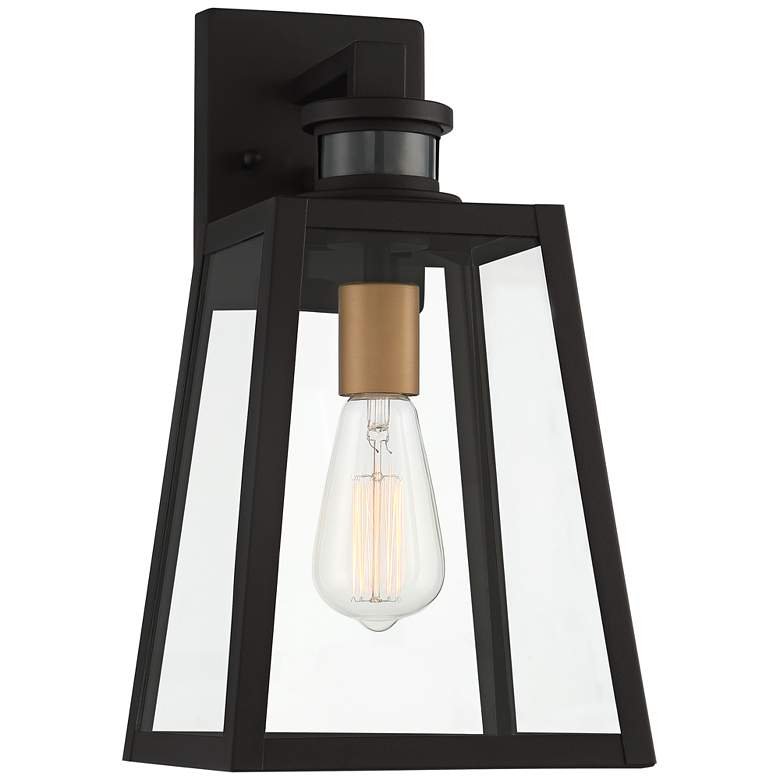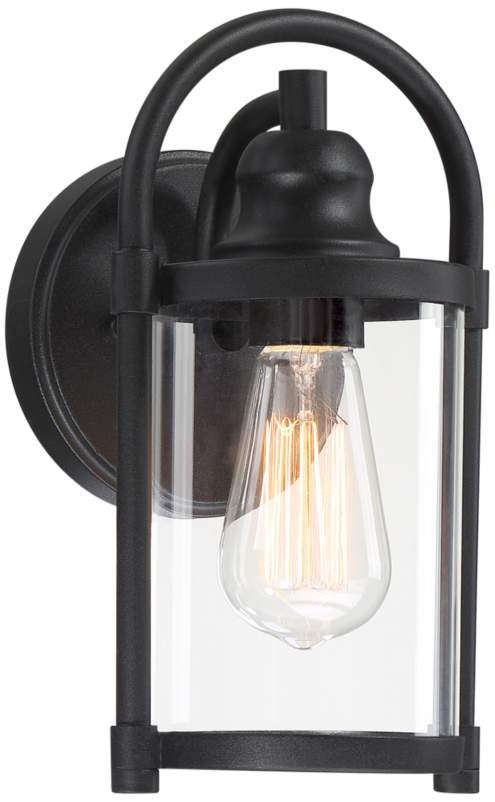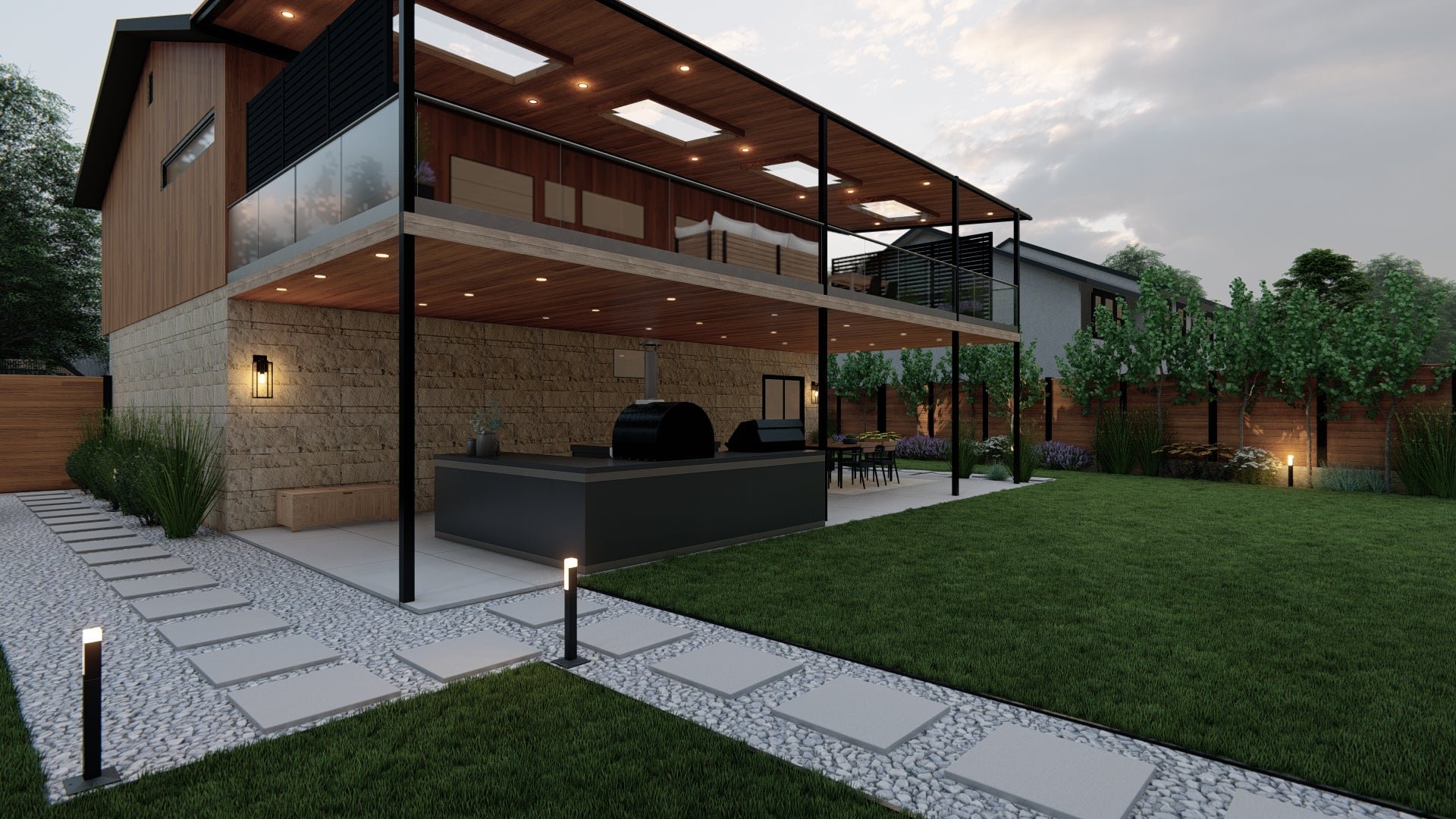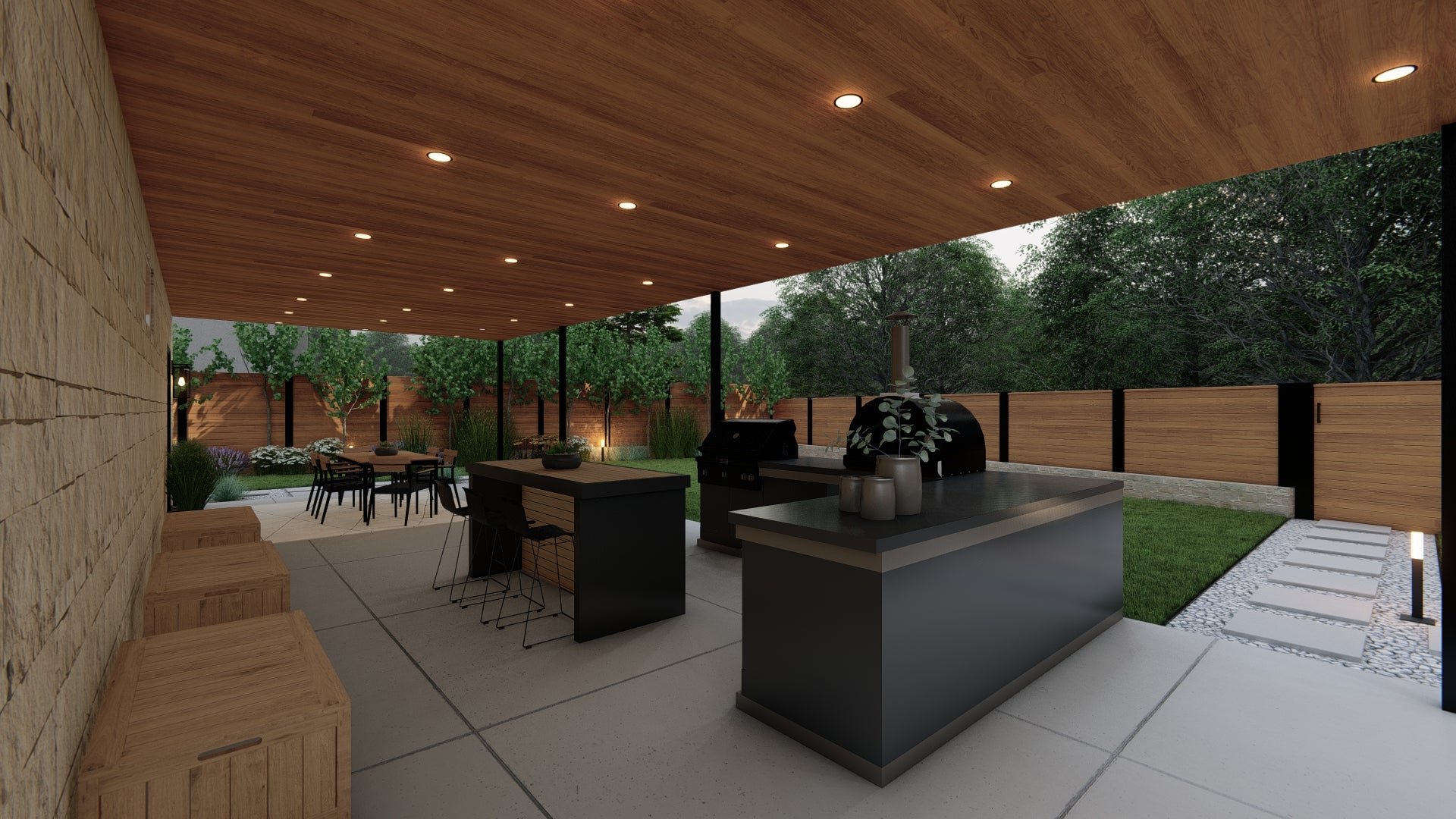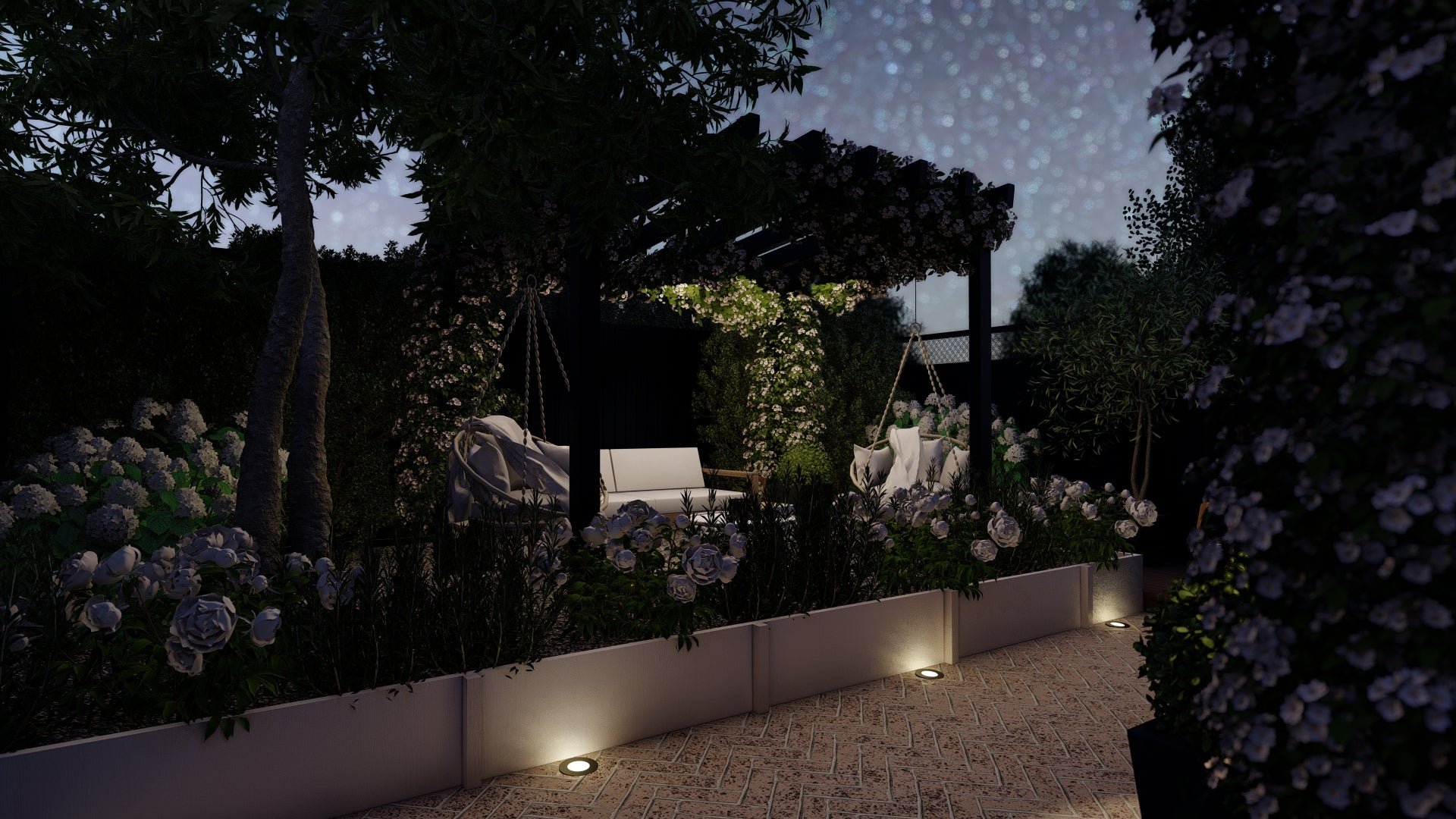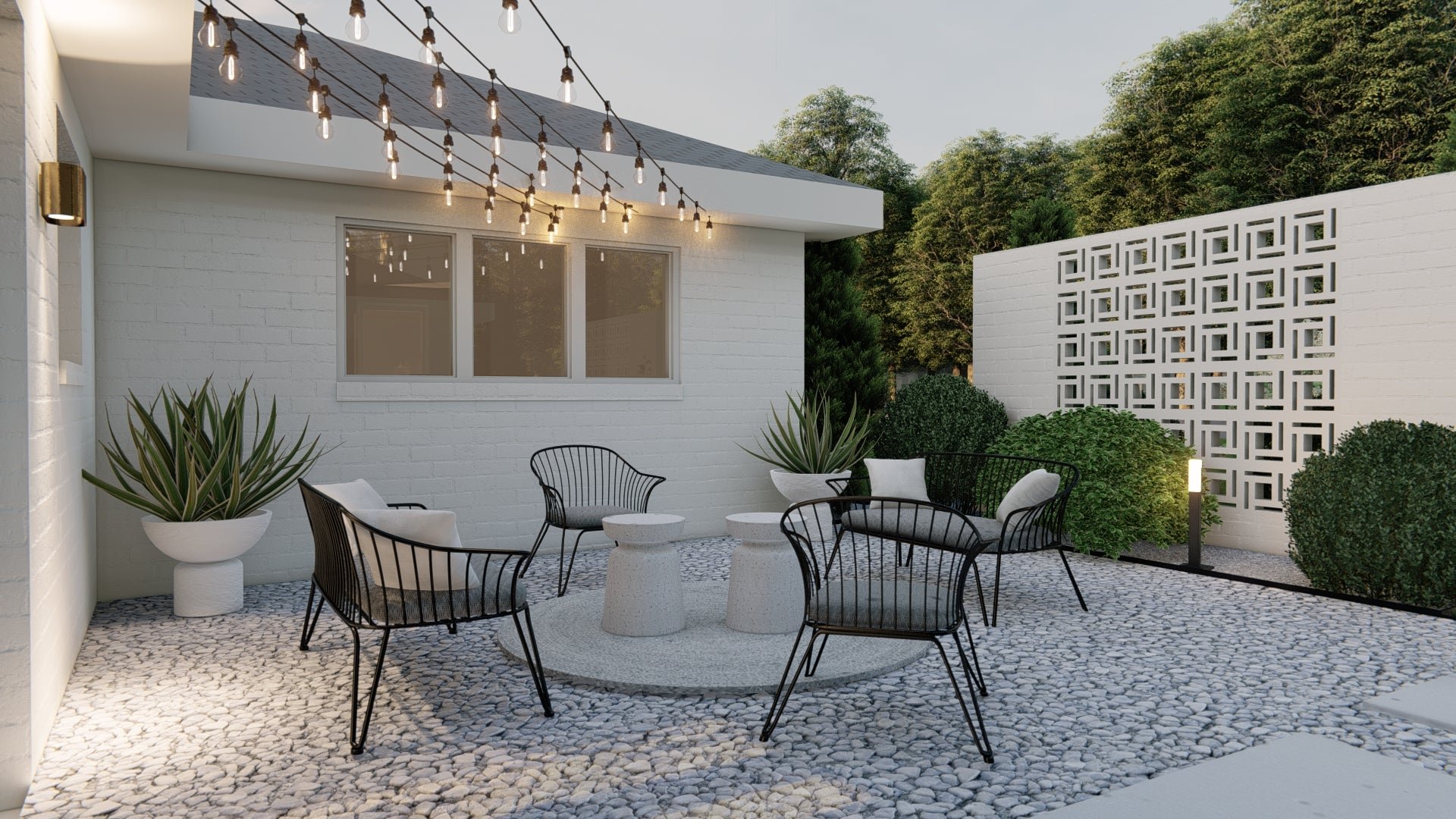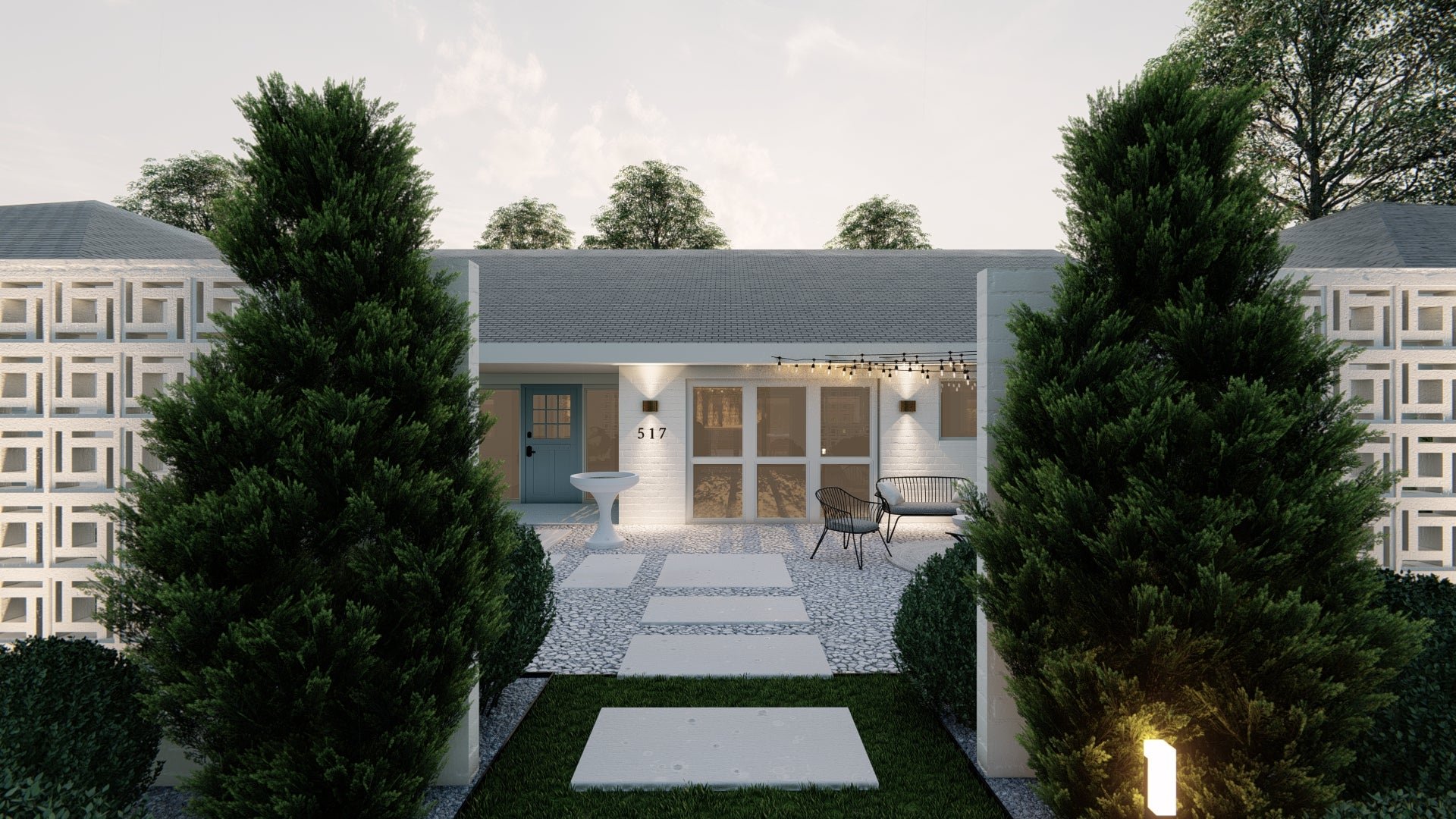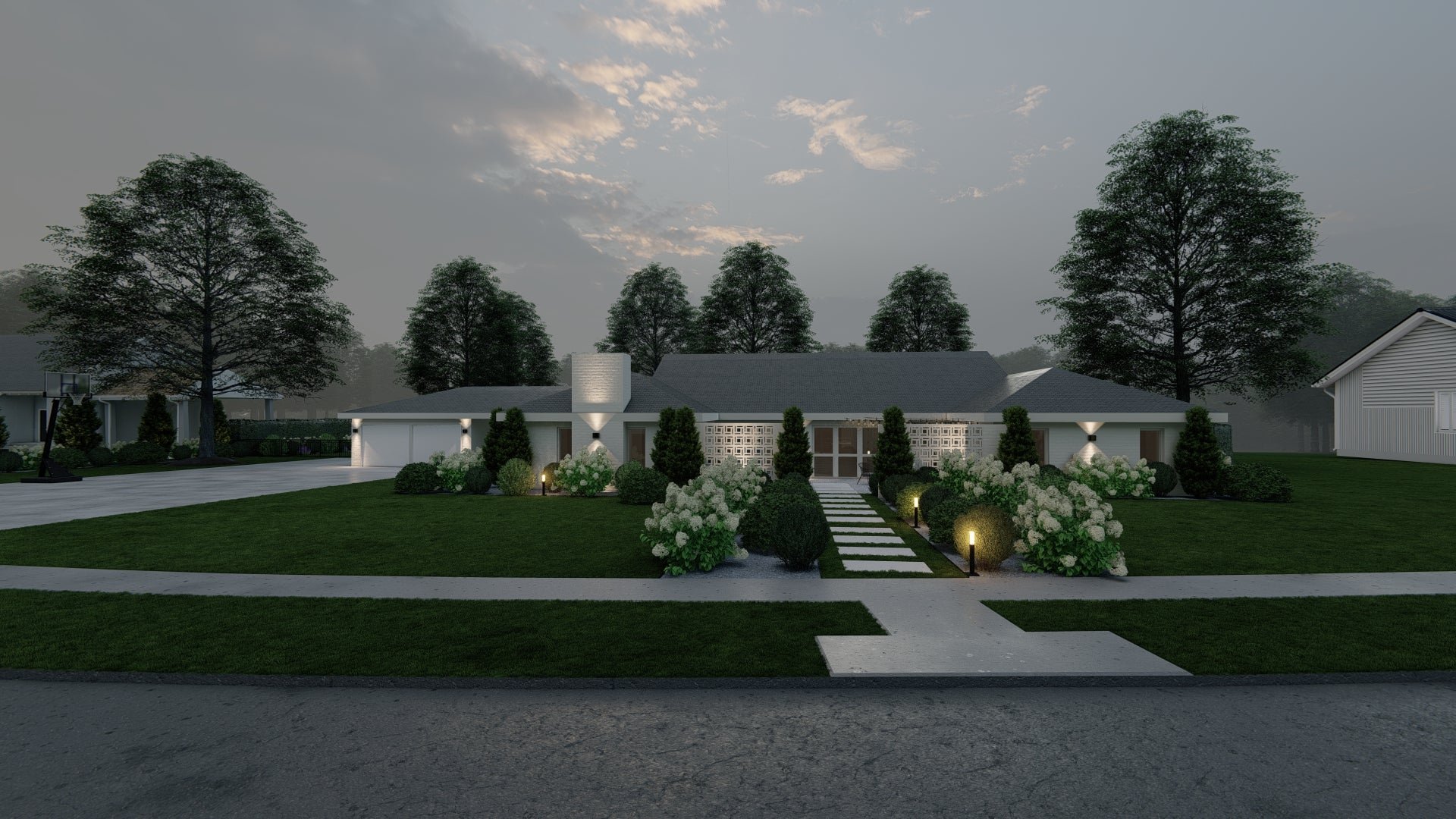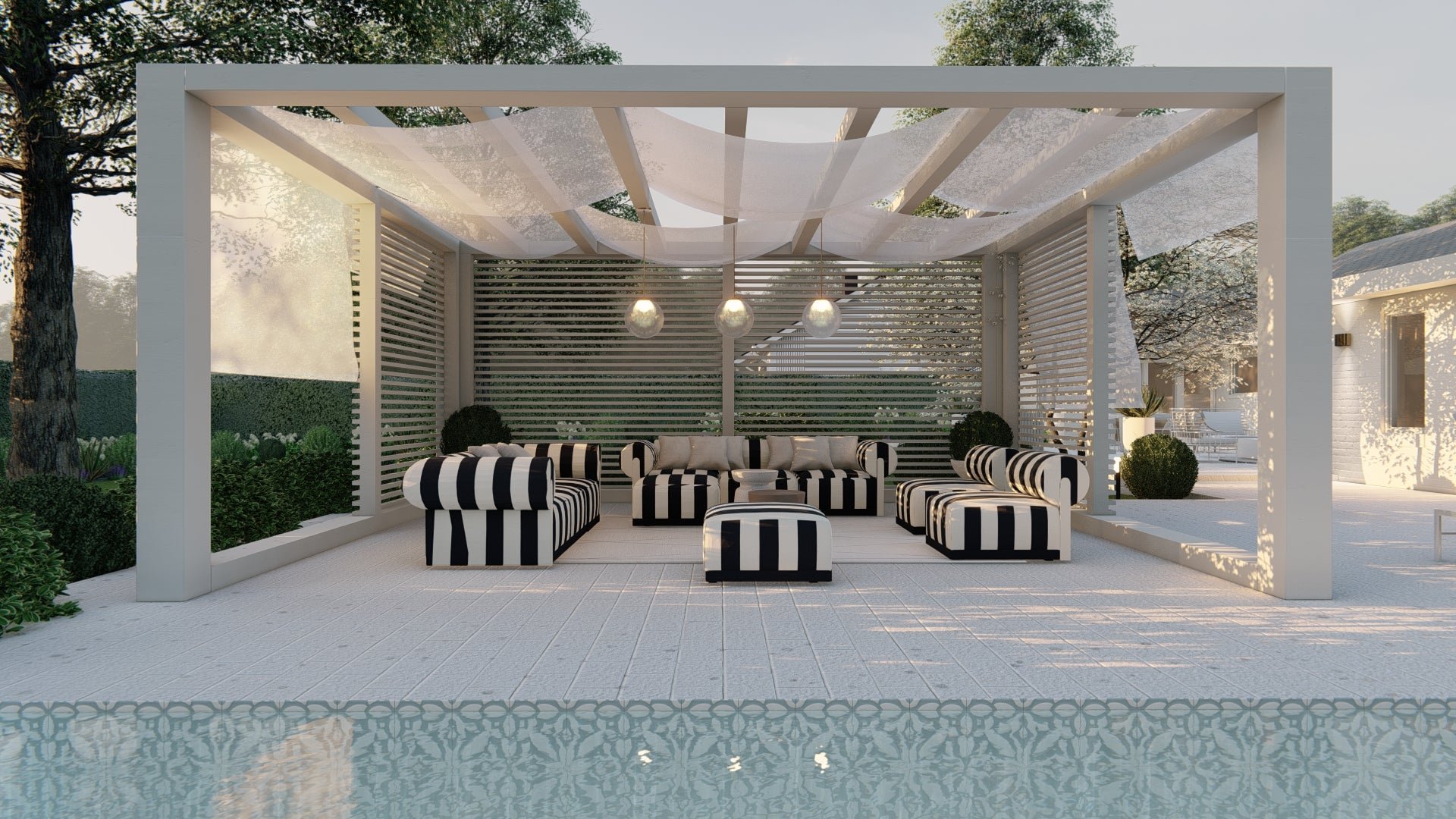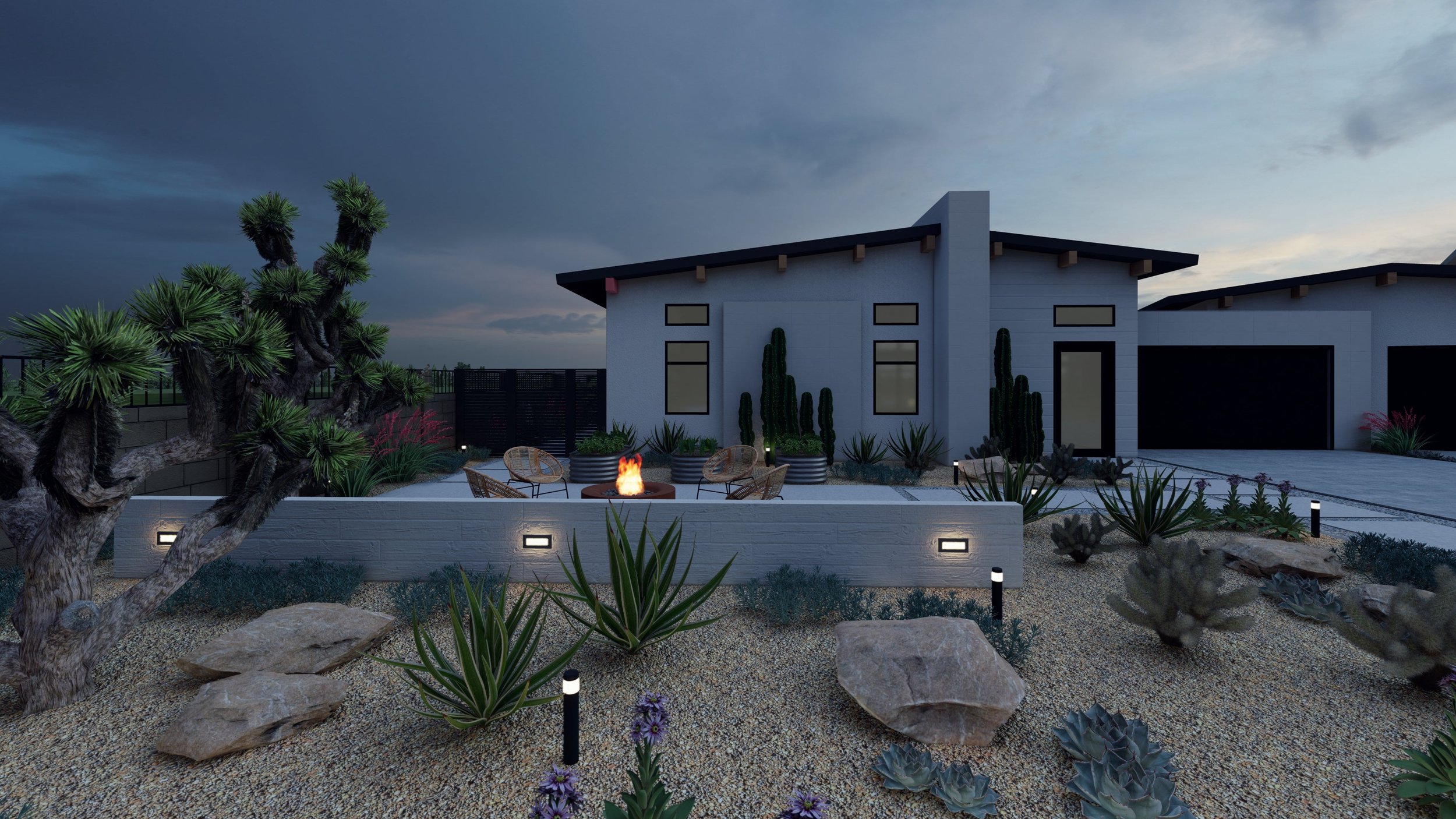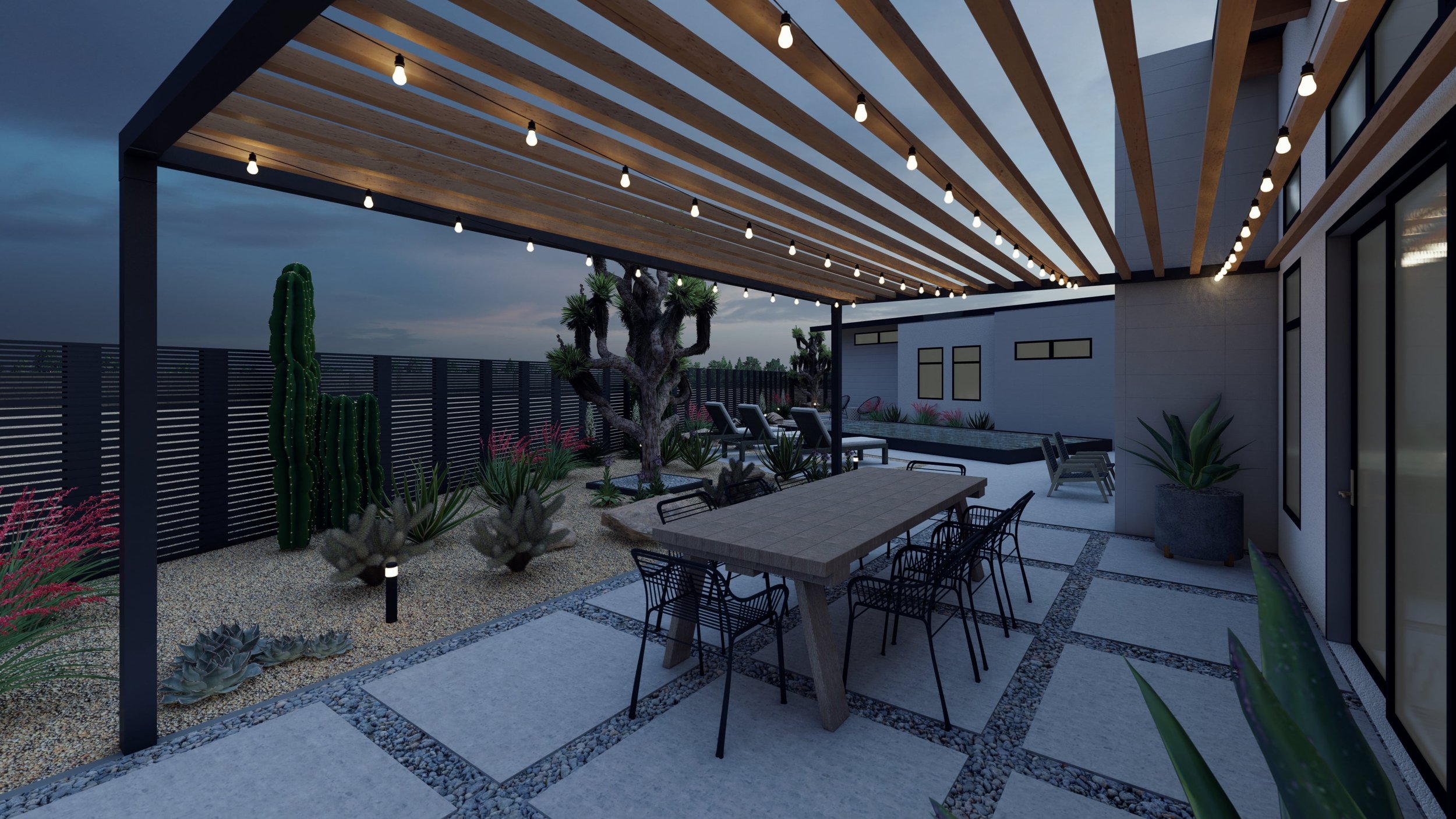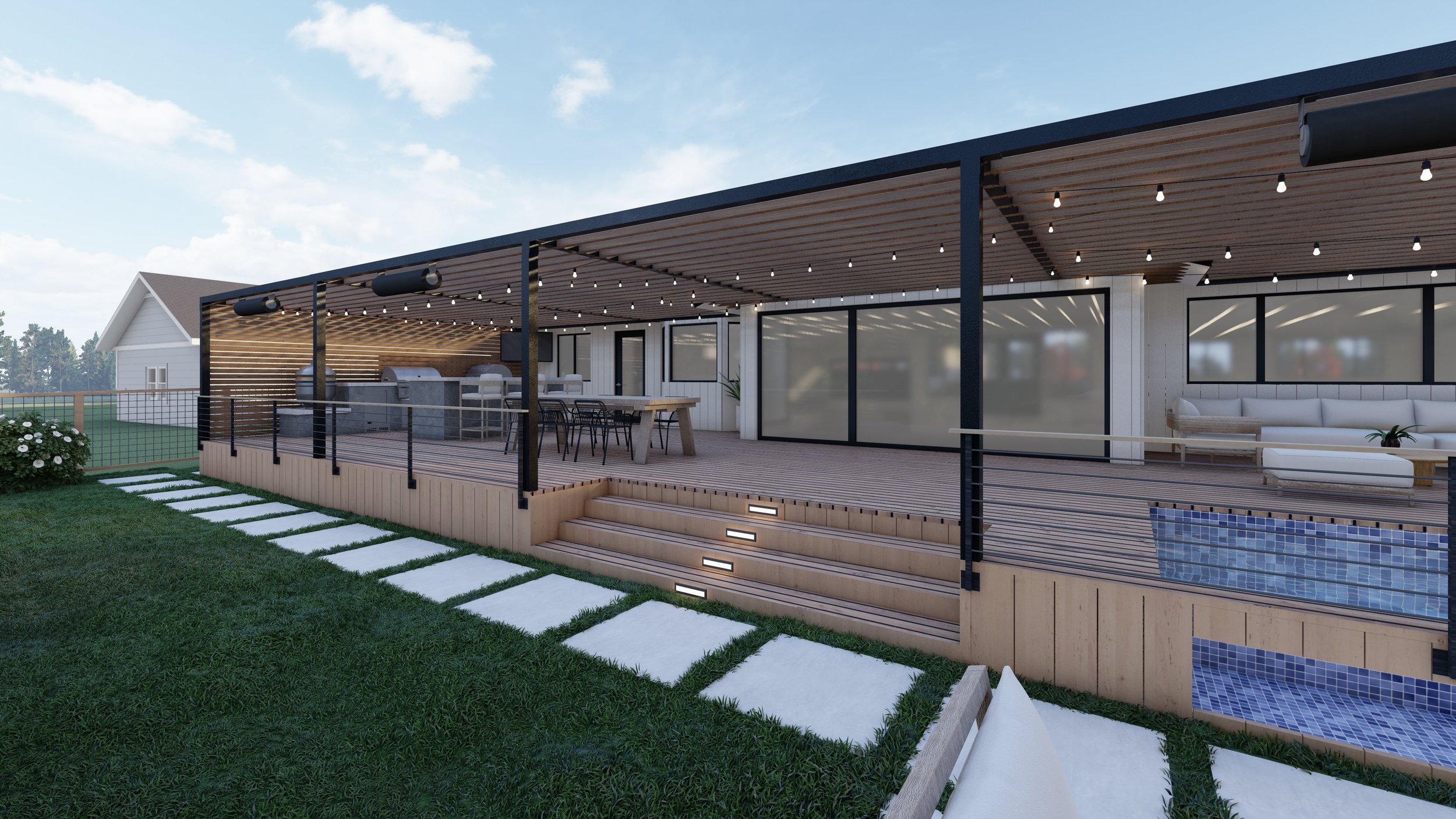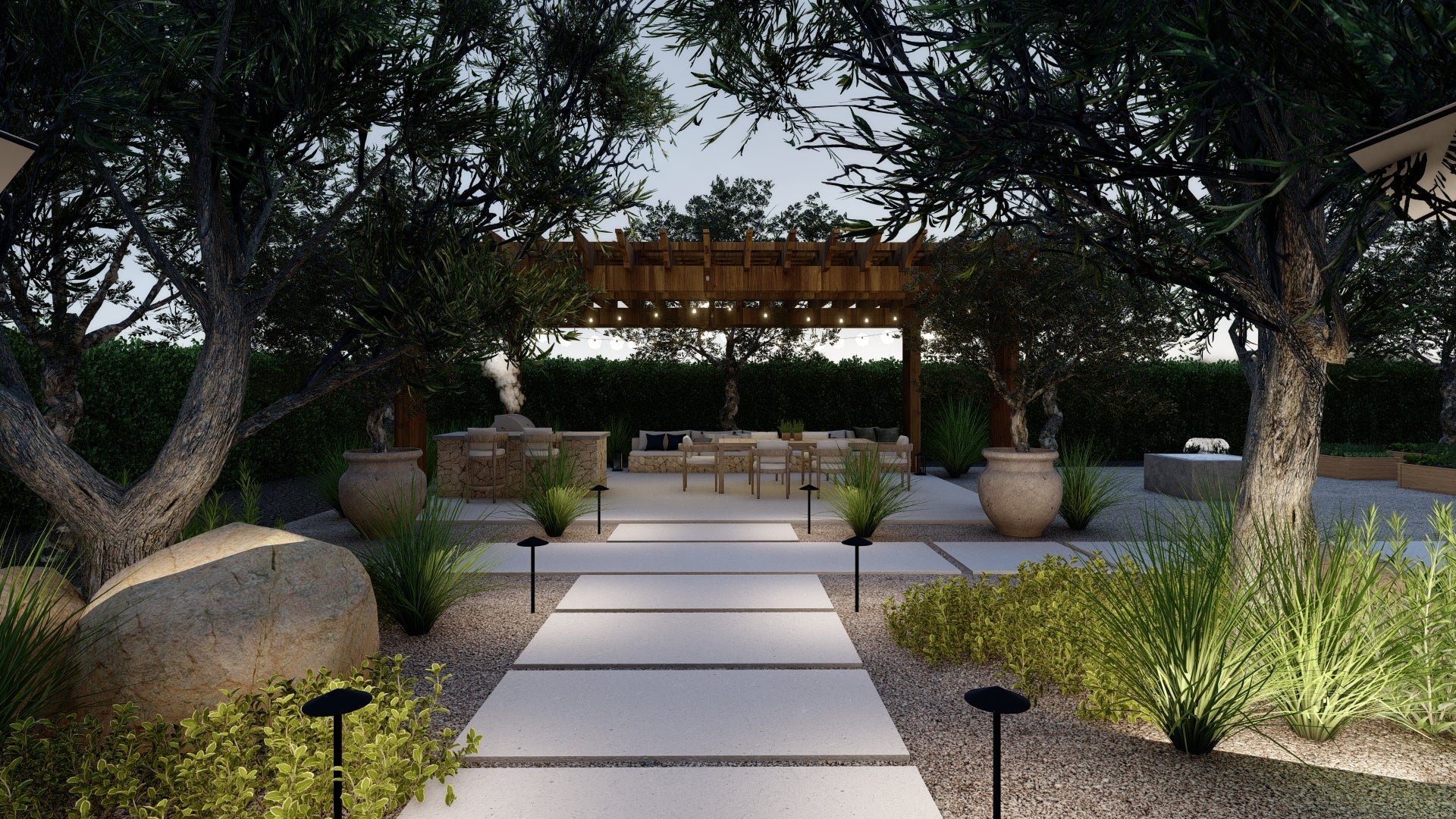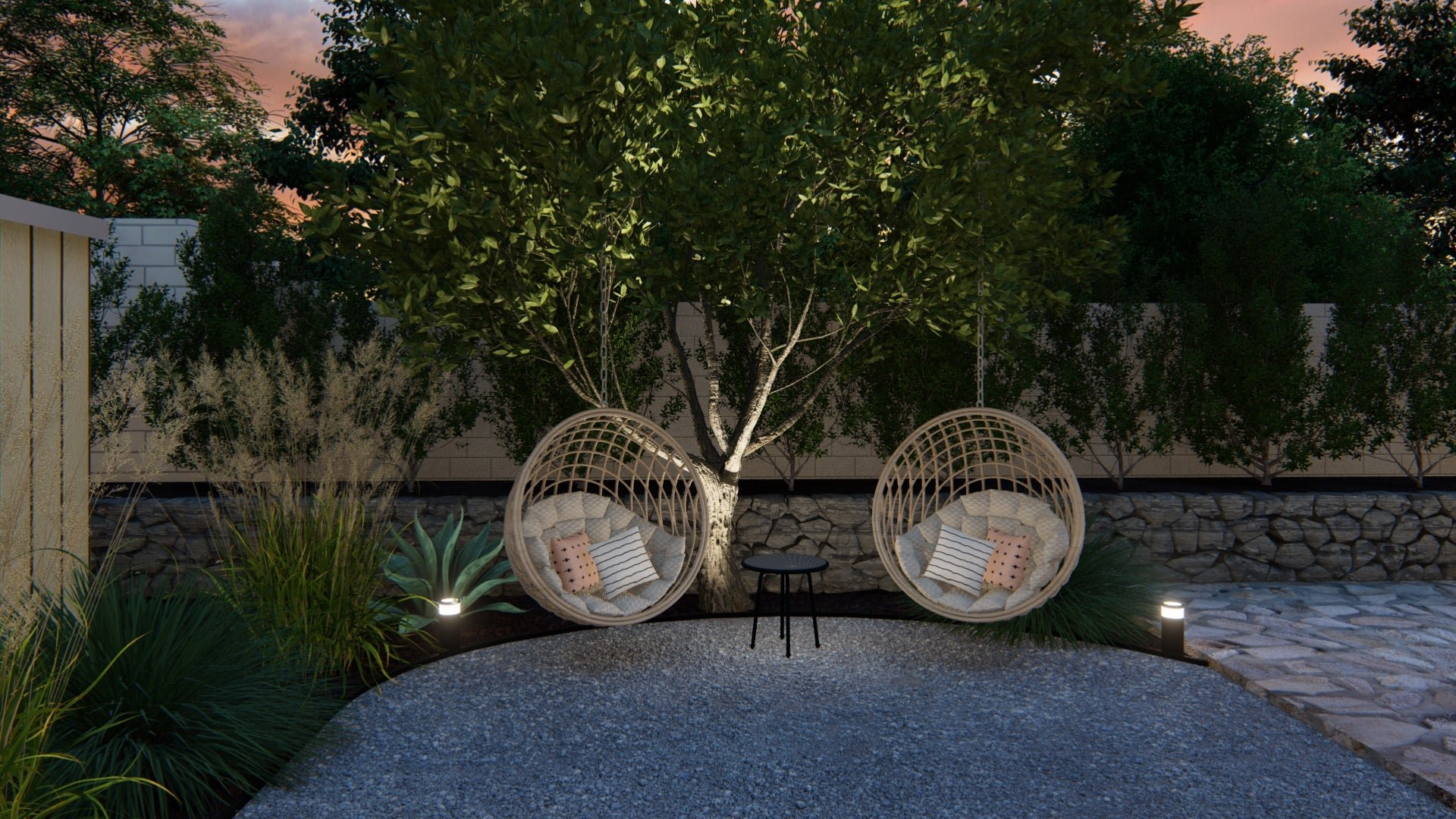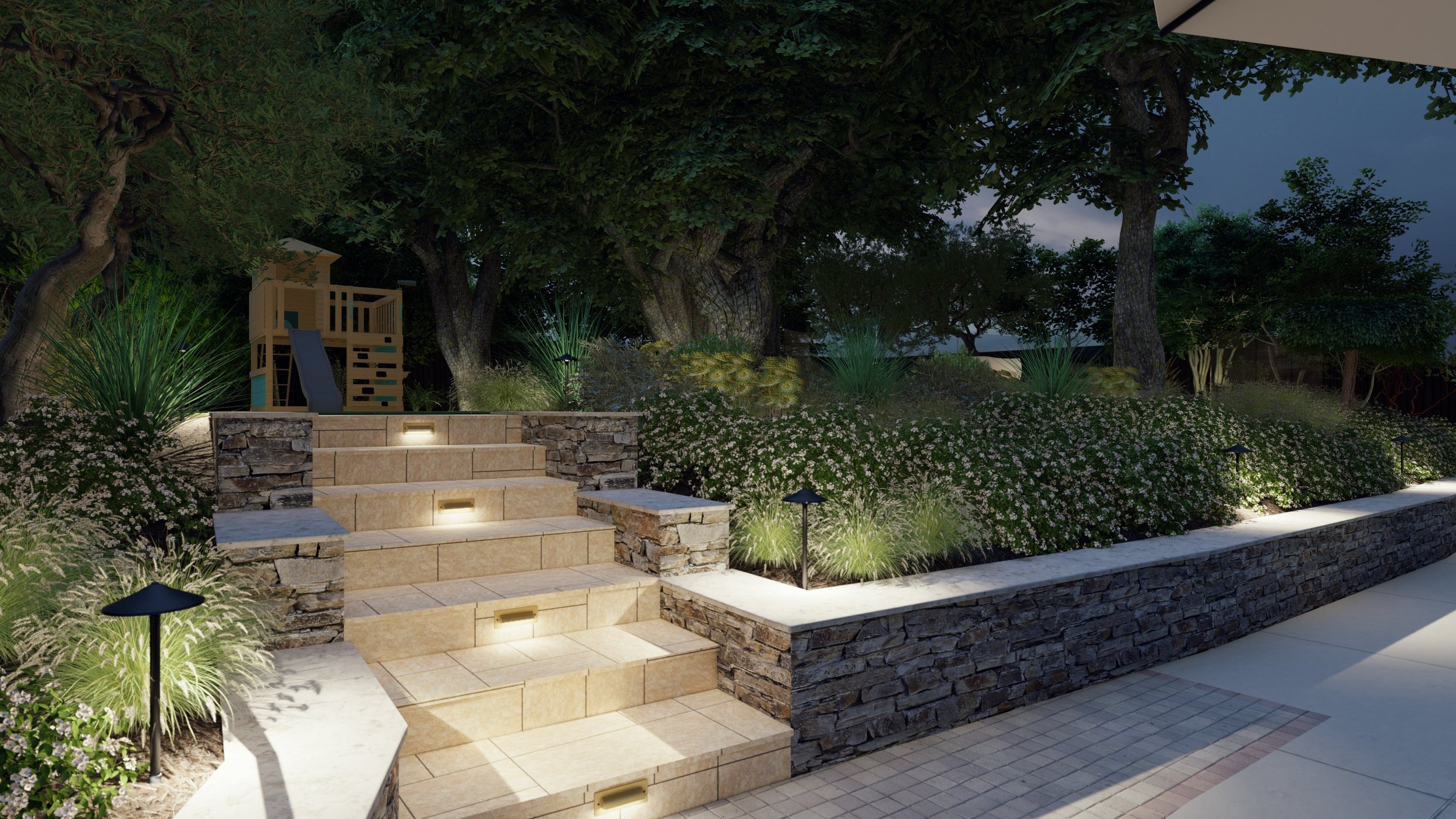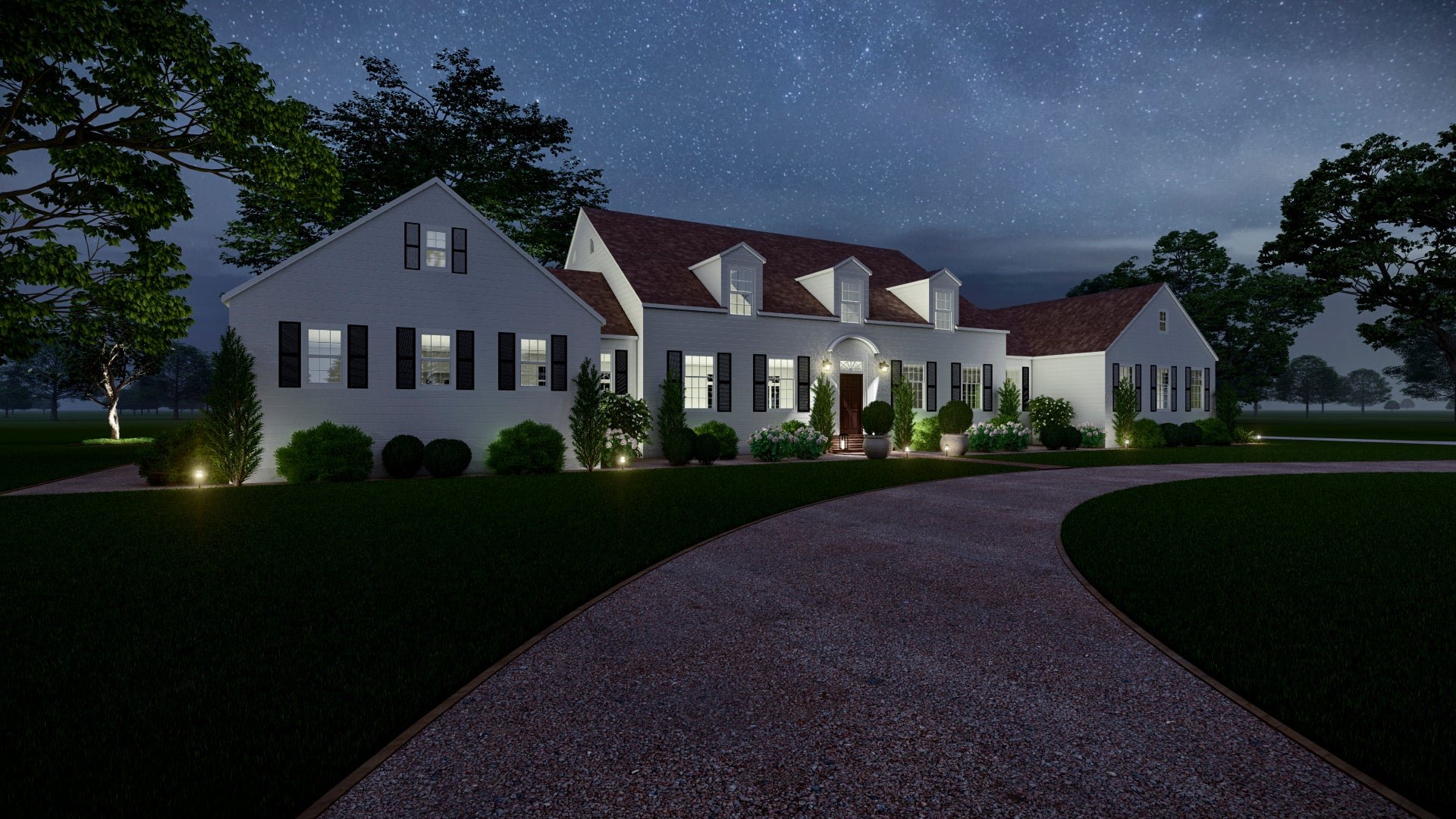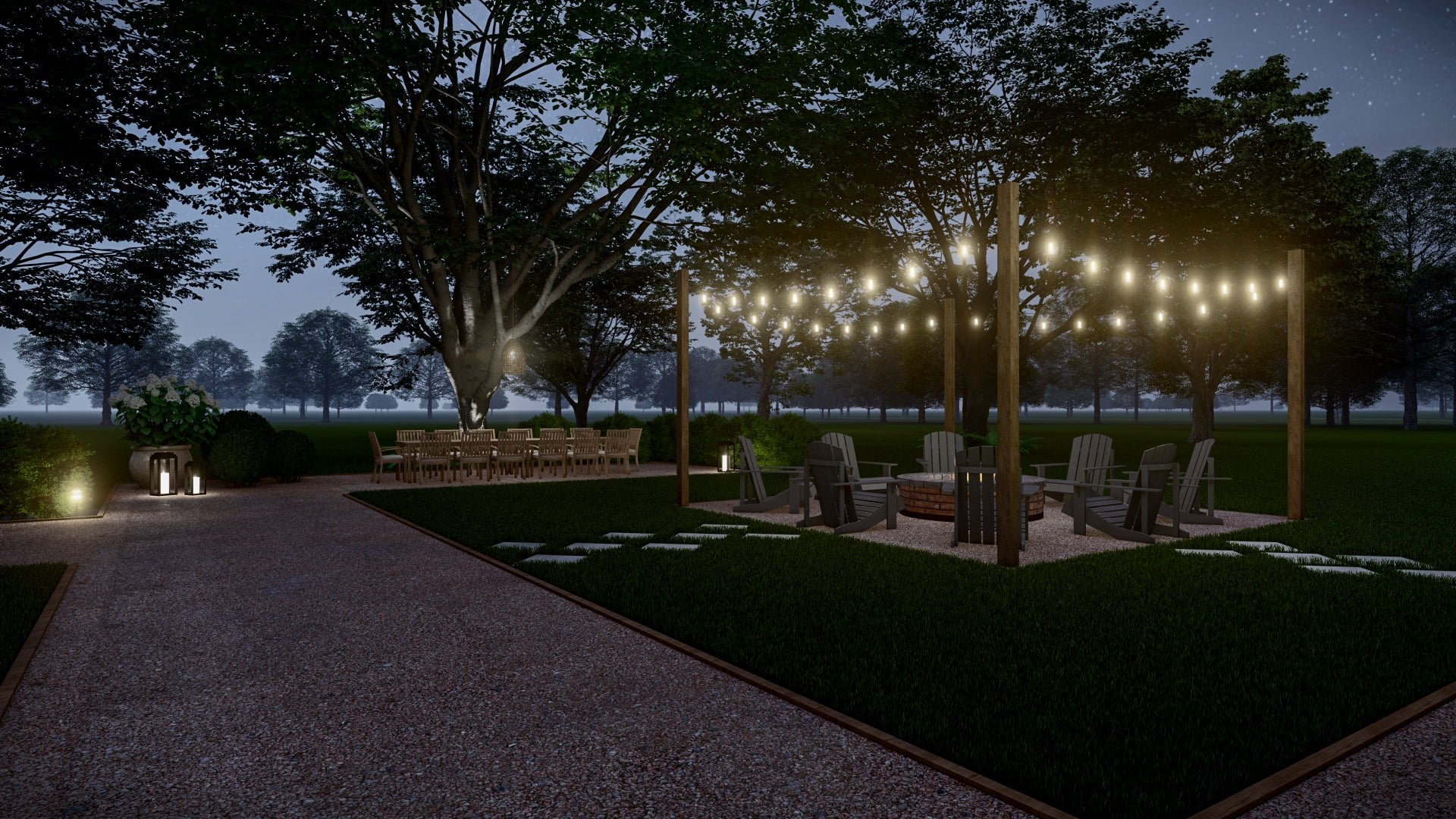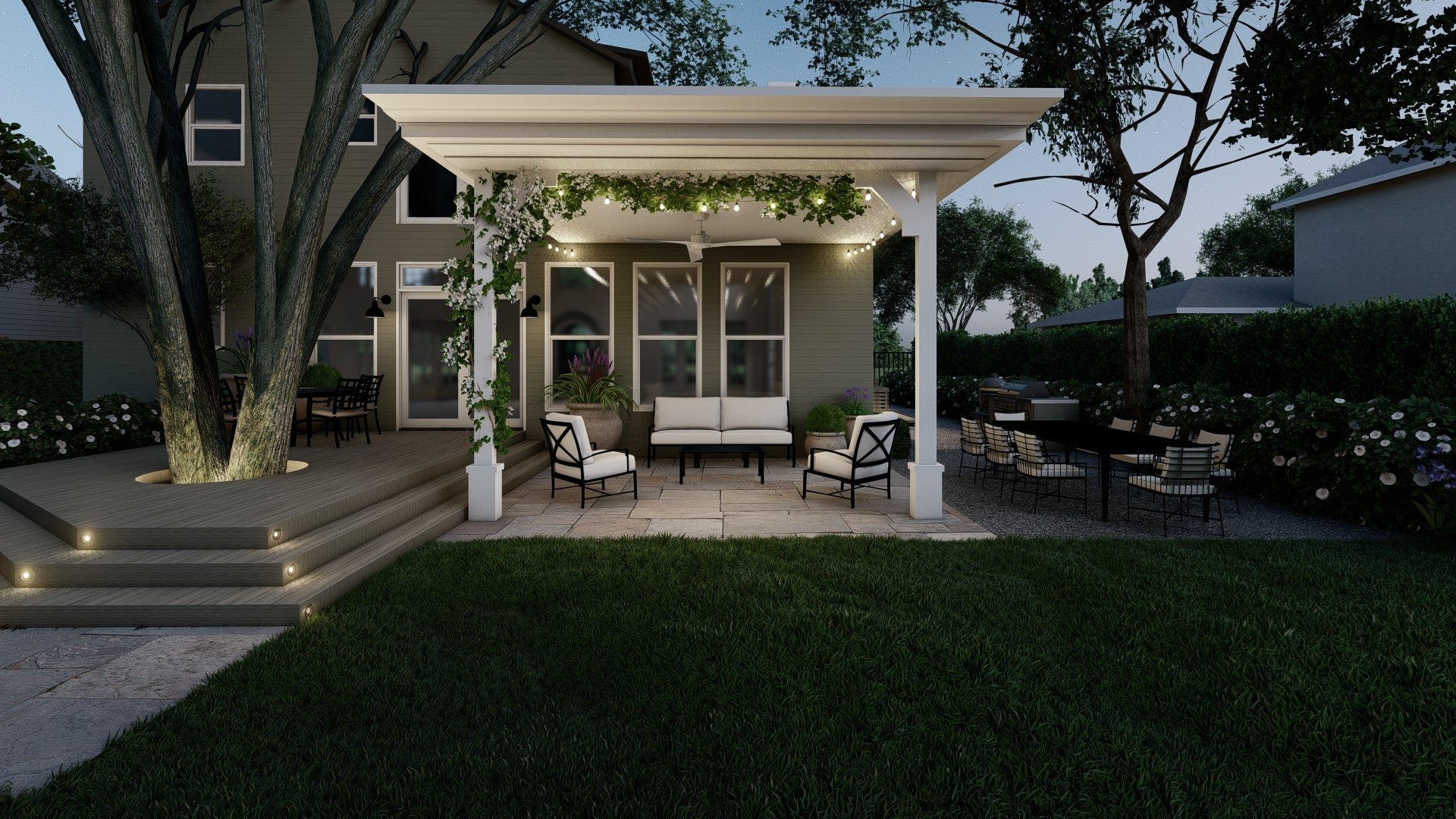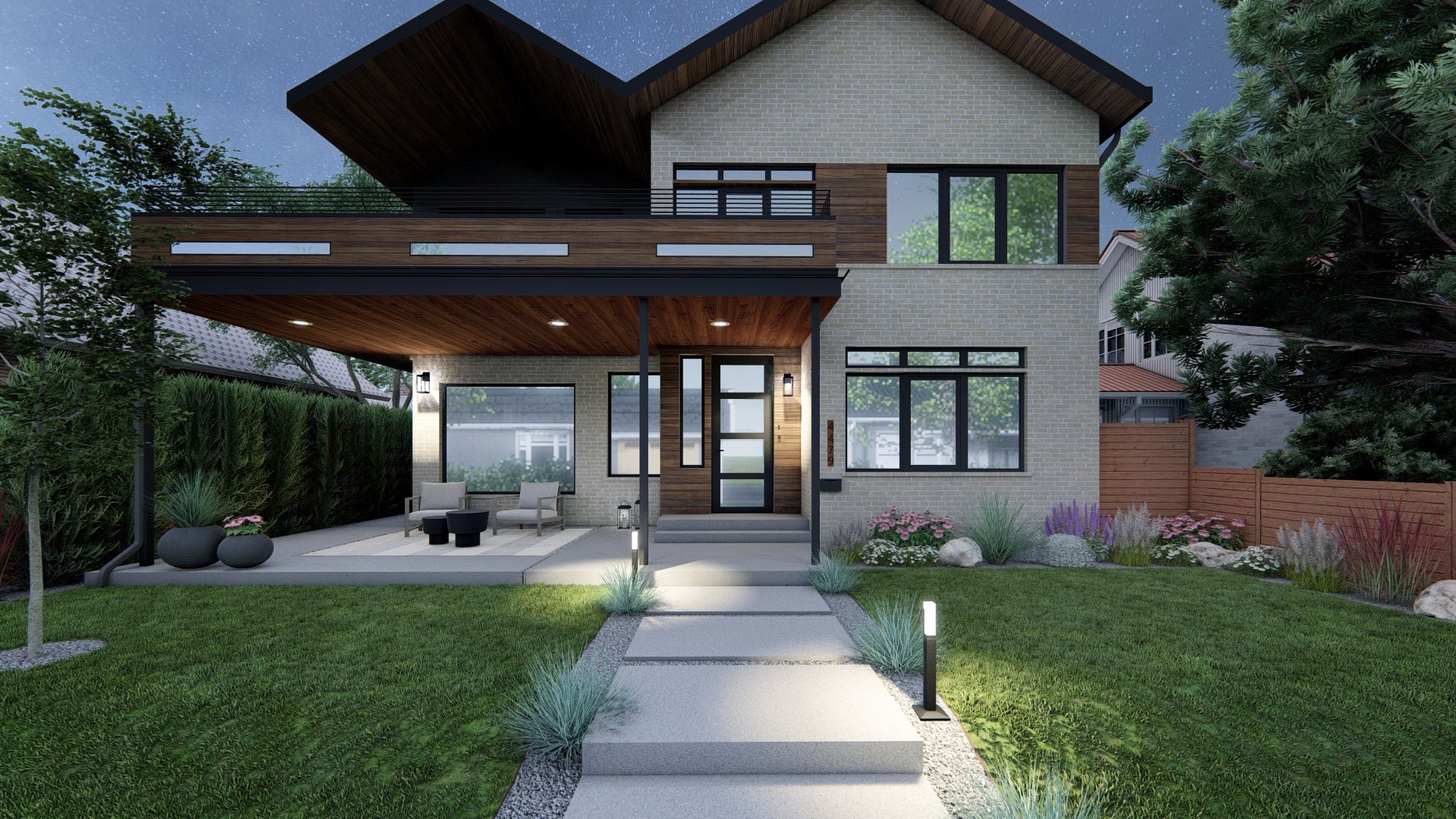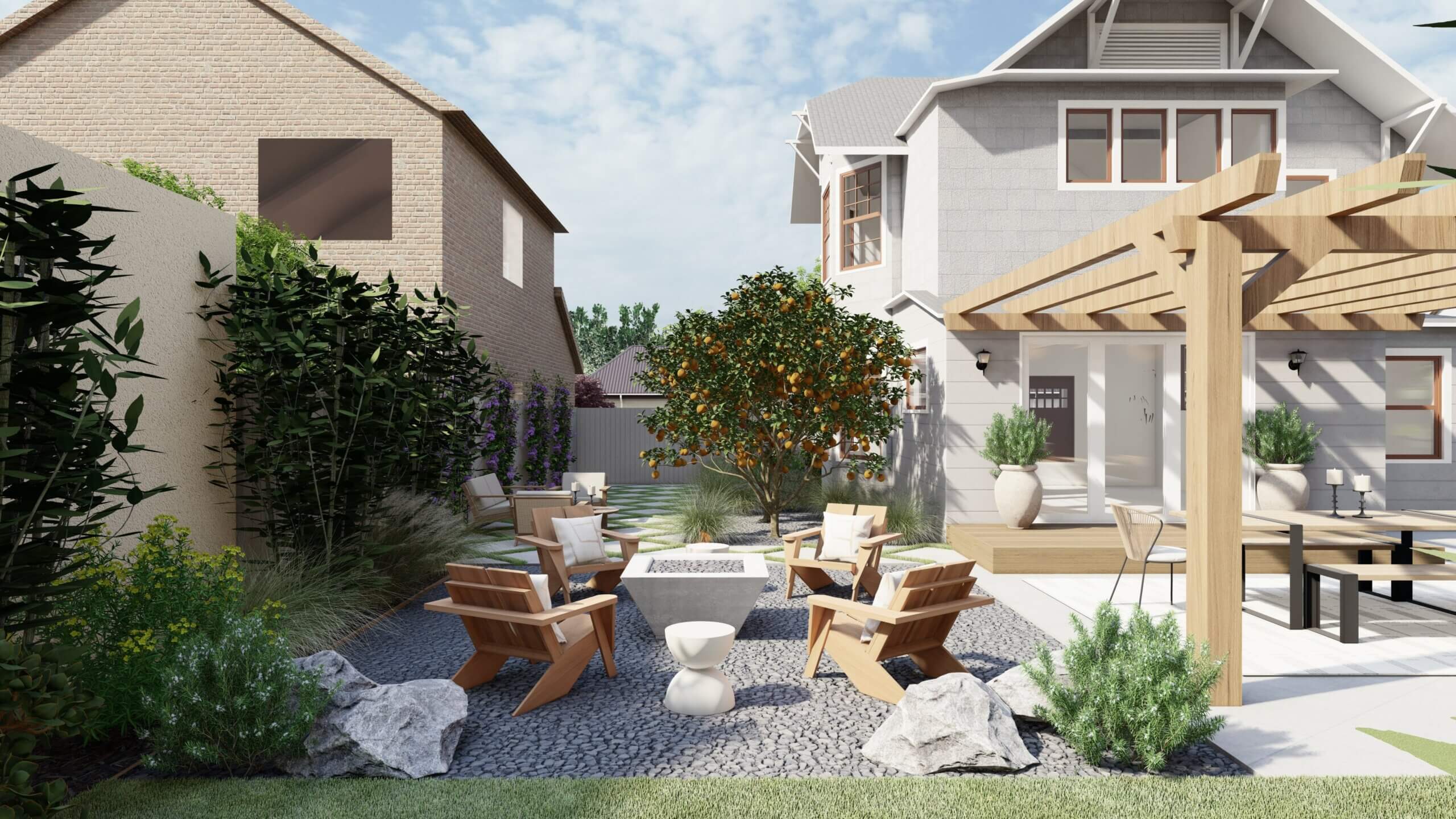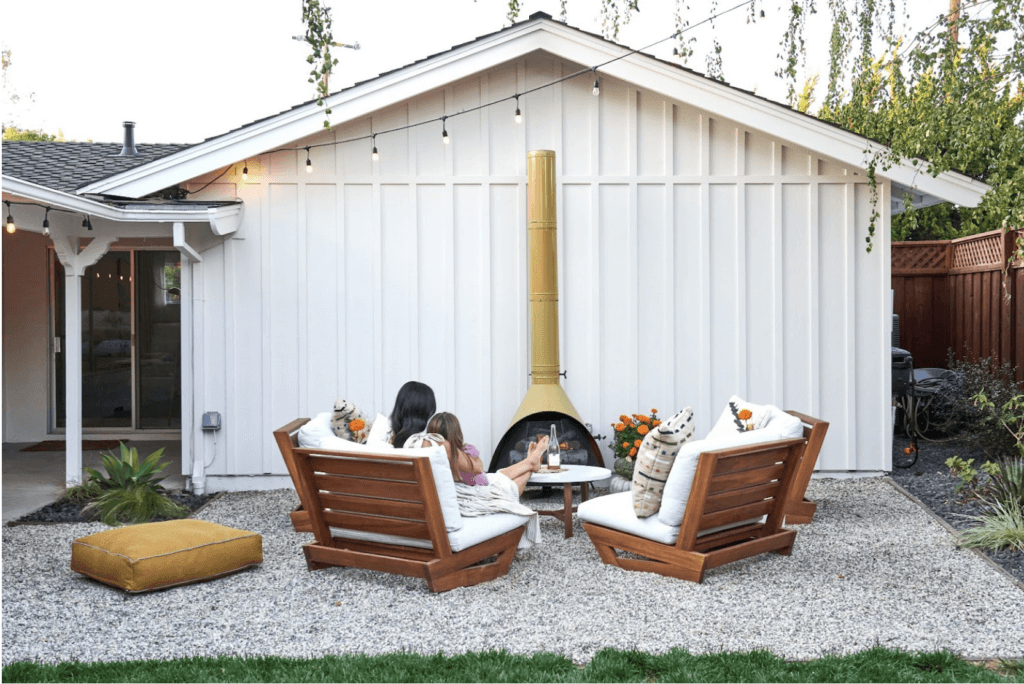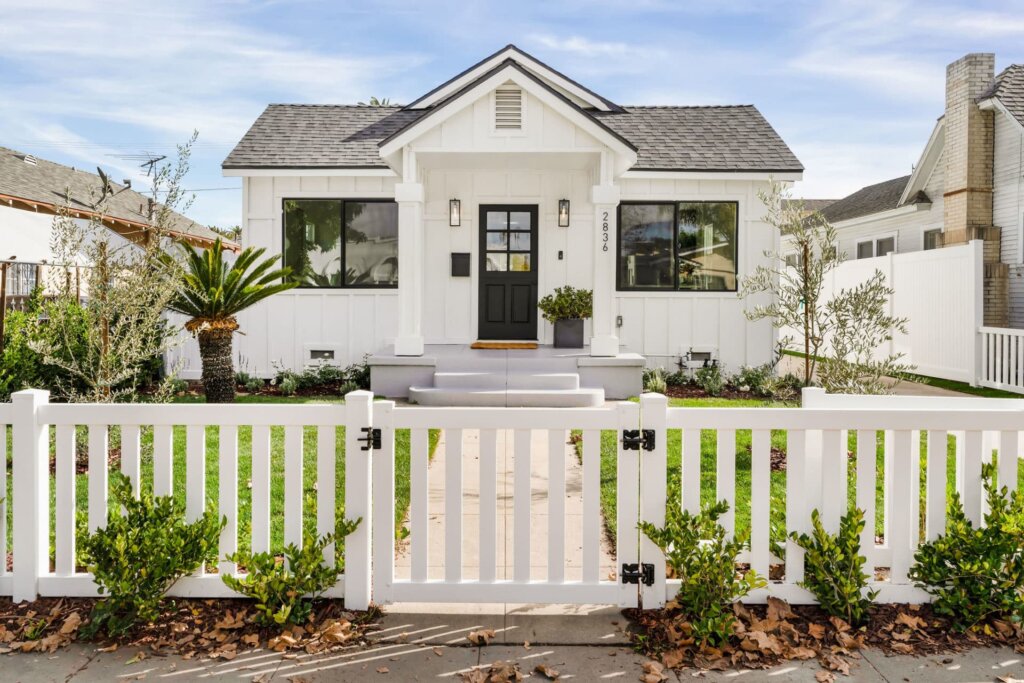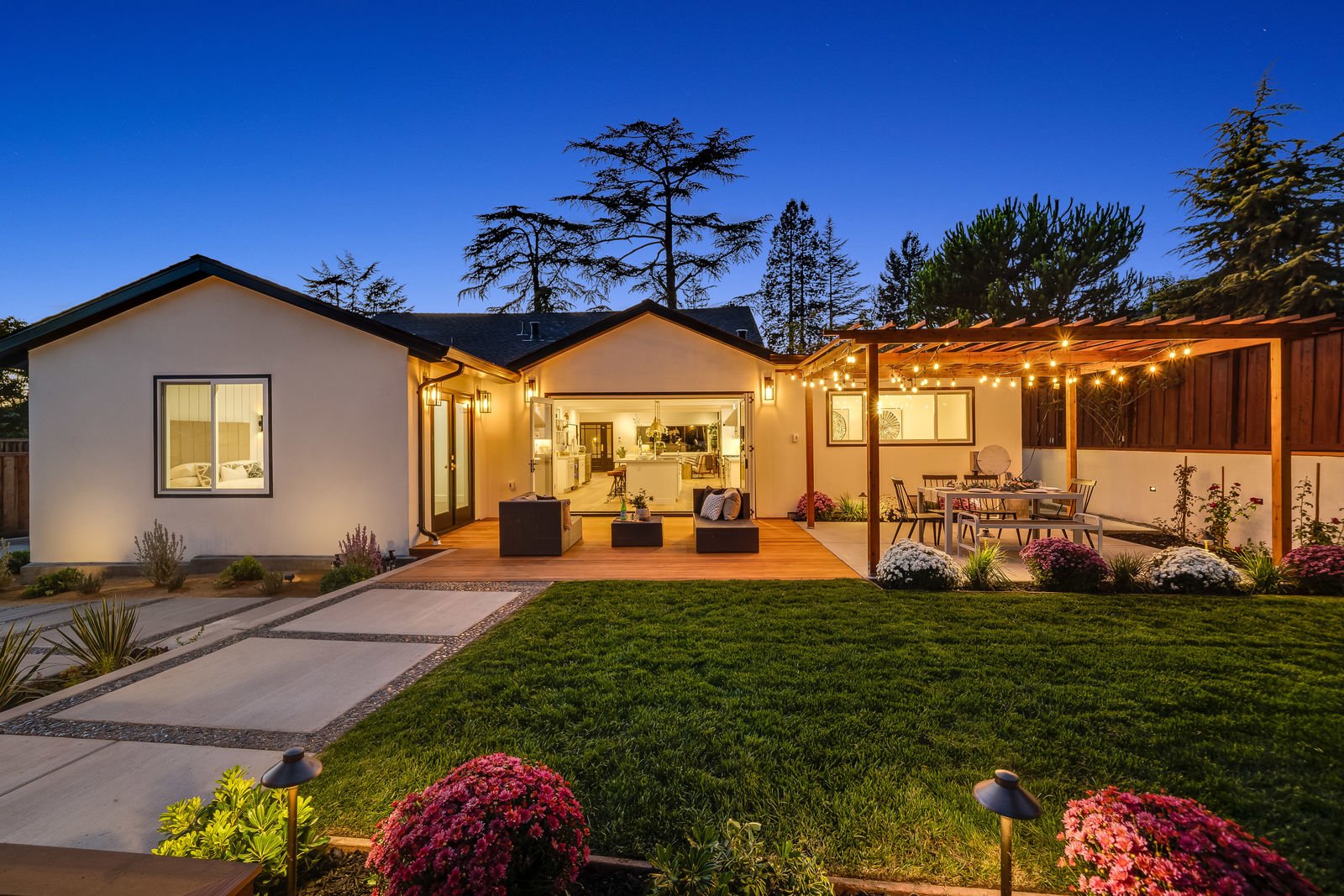
Any photographer, filmmaker, or theater director will tell you: lighting is crucial to composing a scene. Come nightfall, the same principle applies to landscapes.
Contemporary style yard with landscape lighting installed for a Yardzen Client.
Lighting shapes people’s experience of the outdoors at night, ensuring safety, establishing focal points, setting a mood, and most importantly, helping people to remain outside enjoying themselves deep into the evening hours.
What are the different types of lights used in a landscape? How can you successfully include a lighting system in a landscape design?
We’ll examine these questions and more below, looking along the way at a few examples of lighting in Yardzen landscape designs.
Types of Landscape and Outdoor Lighting
Path Lights
Perhaps the most common type of landscape lighting, path lights are shin-height, vertical fixtures that cast light downward (also called downlighting) to illuminate paths in a landscape design.
Path lighting in a Montclair, NJ backyard designed for a Yardzen client.
Path lights aim for safe illumination along the entire length of a path. It’s ok for brightness to swell and fade a bit, but not dramatically so – for safety and ease of movement, lighting should remain relatively even and avoid sudden shifts between darkness and light.
Path Light Tips:
One path light every 15’ is a good rule of thumb for spacing, though brightness and distance of illumination vary from fixture to fixture (defer to manufacturers’ recommended spacing when available).
A light on one side is usually enough. Lights can alternate sides along the path, or stick to one edge – either option looks sharp. Paths wider than 6’ may want lights directly across from each other, but for normal paths this isn’t necessary.
Begin by placing a light at each end of a path. For short paths, two fixtures may be enough, but if you need more, place them at corners or at the apex of curves along the path. For straight paths, space additional fixtures evenly.
Avoid trip hazards. This is a biggie – kicking a light that you didn’t see hurts, and can cause a tumble. Tuck path lights into the front edge of planting areas or other adjacent spaces, safely out of the path of travel.
Avoid placing lights on a path edge shared with a lawn, as people may step off a path onto a lawn at any moment. If a path is surrounded by lawn, place path lights conspicuously to make them easy to avoid.
Path lights are also decorative elements. Use them to emphasize key moments, or to mark a steady rhythm for the eye to follow.
Looking for path light recommendations? The Westley and Feldis path lights look great across a range of styles and fade gracefully into the background during daylight hours. Both are low-voltage lighting fixtures—this is the most common option for residential lighting because they are generally easier and safer to install and don’t require the help of a licensed electrician.
Keep in mind that even if you’re using only low-voltage lighting in your landscape, you or your contractor will still need to consider the transformer used for lighting installation.
Uplights
Uplights are tiny spotlights (often incorrectly called a floodlight) that sit at the base of focal elements, directing light upward. Their effect is dramatic.
A backyard designed by Yardzen in Menlo Park, CA with uplights to illuminate specimen trees.
Uplights are a form of accent lighting used most to commonly light up trees or other tall elements, but they can also be used to wash a fan of light along a wall or fence – a good trick to flank entrances or mark a rhythm along a back fence.
Uplight Design Tips:
Multi-trunked specimen trees look particularly stunning with uplights. Palo Verde, Desert Willow, Dr. Hurd Manzanita, and Olives are among the many sculptural species worthy of uplighting.
Don’t overdo it. Too many uplights make for a messy, hyperbolic scene – when everything is highlighted, nothing is highlighted. For a clean, intentional, powerful look, limit uplighting to a small number of key focal points.
Turn off the lights when you are done for the night. While beautiful, uplights can disrupt local ecosystems and contribute more directly to light pollution than lights that shine downward. Enjoy uplights while you are outside, but shut them off when the evening ends.
Looking for uplight recommendations? Here are a couple low-voltage options we love, in bronze and black, each available at Lamps Plus.
Recessed Lights
Recessed lighting buries the body of the light within a wall, paving, decking, or other feature, so that only the framed lens of the light is visible. They look like a small, glowing shape within the surface of a built feature.
Recessed in-ground well lights in a Bay Area backyard designed by Yardzen.
Front yard designed by Yardzen with recessed lighting in the ceiling of the covered front walkway.
Landscape designs, especially modern ones, commonly feature recessed lighting in the risers of stairs, on the face of concrete walls, or pointing upward along the edge of a deck.
Recessed Light Tips:
Recessed lights cannot be placed into existing concrete features – you’d have to break the concrete to get the light into it. New concrete features, on the other hand, can accommodate recessed lighting by including designated space to hold the fixture and its wiring.
Recessed lights work differently than path lights. In-ground recessed lights direct light upward. This is useful for indicating the edge of a deck or path, but does not cast much light across the actual walking surface. If your aim is to light an entire path, we suggest above-ground fixtures.
Looking for recessed light recommendations? For in-ground applications, we recommend this compact well light, or, for higher traffic zones, this heavy duty aluminum light. For vertical surfaces like walls or stair risers, we love the sleek design of Luna step light by Hinkley. These fixtures are all low-voltage.
Deck Lights
Deck lights are usually mounted as downlighting on the posts of railings or pergolas where they project light downward, though some “up/down” models cast light upward as well.
Deck lights on a modern railing from Yardzen partner TimberTech.
A backyard designed by Yardzen for an Eichler home in Castro Valley, CA with deck lighting along the sides of the deck illuminating the lower level of the yard.
As with any landscape light fixture, deck lights can be minimal, or more decorative.
Deck Light Tips:
Mount deck lights high up on the posts of railings to maximize the spread of their illumination.
Deck lights can also be mounted on the underside of built features. Try deck lights under the top rail of deck railings, or even underneath built-in benches. LED strip lighting, which runs longer distances, is often a great choice for this approach.
Looking for deck light recommendations? Try the low-voltage Nuvi Bronze Deck Light by Hinkley.
String Lights
Also called cafe, catenary, or bistro lighting, string lights are a cost effective, charming way to brighten up outdoor spaces and create ambiance.
Walnut Creek, CA backyard designed by Yardzen.
String lights plug directly into standard electrical outlets, making them a breeze to install, and convenient for use as a temporary or permanent feature in a landscape design.
String Light Tips:
Go easy. String lights look great at night, but look like power lines during the day. Use enough to achieve the illumination and style you need, but no more. Avoid running string lights across key views, or dangling them over long distances.
Mount string lights to existing infrastructure. Lace them along the underside of pergolas or covered patios, or hitch them to the top of fence posts or eaves.
You can also hang lights from basic wood posts. String lights are lightweight, and require only a slender post with a firm anchor (typically a concrete footing) to support their weight. DIY types can manage this themselves with a plant container. You can also buy readymade string light pole kits, though we recommend sturdier, more permanent solutions to avoid maintenance issues down the road.
Looking for string light recommendations? We love CB2’s Edison String Lights.
Hanging Lights
Hanging lights are a step up from string lights, and highly effective at bringing an elevated, indoor feel to outdoor spaces.
Front yard and entryway designed by Yardzen in Walnut Creek, CA with hanging light above the front door and recessed lighting on the porch stair risers.
Because they attract attention, and because we associate them with the indoors, hanging lights have an outsized impact on the perceived style of a space. Consequently, they offer designers a simple but very effective way to ramp up the style of outdoor spaces.
Hanging Light Tips:
Hang a single showpiece light for a more formal look.
For an eclectic, Bohemian feel, cluster a few fixtures together, hanging them at different heights.
Choose a fixture to suit the scale of the space. Small space? Smaller fixture. Large space? Larger fixture, or, distribute multiple fixtures over a few key areas.
Looking for hanging light recommendations? This Nyack bronze lantern is a showstopper, and this Quoizel Westover light works beautifully across a broad range of design styles. Those seeking a casual feel could also try this Civic hanging light, and modern aficionados will love this Capsule light.
Wall Lights
Wall lights typically mount to the wall of the house, shining down or out from well above eye level. When outdoor spaces are located adjacent to the house, wall lights can be a key source of illumination.
Wall lights illuminate entryways and seating areas in a Santa Monica, CA backyard designed by Yardzen.
Wall lights come in a dizzying variety of styles, and go a long way toward establishing a look for both the home and its exterior spaces.
Wall Light Tips:
Place wall lights near exterior doors. This makes for easy wayfinding, and highlights a natural focal point.
Wall lights are highly visible – don’t go overboard. A bright light mounted up high is a bold gesture. A few carefully placed lights will bring out the best in your home’s exterior, but, as with uplights, too many wall lights gets to be a bit over-the-top.
Looking for wall light recommendations? The Arrington is a standby, at home in numerous design styles. You can say the same for the Avani. The Double Box is stunning, with a pale brass finish that looks particularly sharp in warm climates. Farmhouse fans will love the Gough wall light.
Landscape Lighting Design Tips
Invisible by Day, Attractive by Night
As a general rule, landscape lighting fixtures should come to life at night, and recede into the background during the day. It’s often best when you don’t notice the fixtures at all during daylight hours.
This rule applies mostly to path and deck light layouts, which physically intervene in people’s experience of a yard more directly than other lighting types.
There are some exceptions to this rule. Some path lights are meant to be showy, and are positioned conspicuously for their decorative value during daylight hours. Hanging lights are almost always selected for visual impact, as are many wall lights.
For the most part, however, landscape light fixtures feel most cohesive within a landscape design when they attract as little attention to themselves as possible during the daytime.
For this reason, selecting understated fixtures and finding ways to de-emphasize their presence tends to be a winning strategy, directing people’s attention to the big picture design rather than little lighting details.
No Glare
Glare occurs when lights are directed upward into people’s eyes. In addition to being uncomfortable, glare can be a safety issue with respect to limiting people’s ability to navigate paths or stairs.
Landscape lighting system selections should prioritize avoiding glare. Direct uplights away from paths or other gathering spaces, choose path lights that cast light downward, and make sure in-ground lighting keeps its light to the edges of the path of travel.
Focal Points
In dark landscapes, our eyes instinctively go to sources of light.
Bearing this in mind, designers can use landscape lighting to add extra emphasis to focal points like exterior doors, specimen trees, or structural features like pergolas.
Perceived Space
Lighting can also be employed to moderate the perceived size of a landscape at night.
By placing lights in the distance, a yard can be made to seem larger. Keeping lights close and allowing the background to remain dark will make a night landscape feel smaller.
Consistent Style
Cohesiveness is all in landscape designs. Landscapes are at their best when all their different elements work together as a harmonious whole.
In this spirit, select landscape light fixtures that express a consistent style. Not everything needs to perfectly match, but each fixture should make sense with the others.
Lights Off at Evening’s End
We mentioned this already, but it bears repeating: enjoy your landscape lighting while you are outside, but avoid leaving lights on all night.
By turning out the lights when they’re not in use, you can do your part to reduce light pollution and support local ecosystems.
Landscape Lighting in Yardzen Designs
Now that you know a bit about lighting in landscape designs, let’s take a look at some Yardzen projects for lighting inspiration.
Bremerton, WA
Minimalist path lighting, a black wall lantern, and gridded recessed ceiling lights add modern detailing to this design.
Uplights on a horizontal wood fence in the distance emphasize a material connection with the slatted wood ceiling of the covered patio.
Mill Valley, CA
Simple recessed lighting washes light along a low retaining wall.
Norman, OK
Strands of string lighting cut a 45 degree angle across this patio. The angle lends character by breaking up the squareness of the space.
Uplights emphasize the patterns in a pair of breeze block walls, while up/down wall lights and a run of string lights create a pleasant, moderate glow in the entry patio.
Evenly spaced wall and path lights pull the eye to the front entrance while boosting curb appeal.
A trio of hanging lights hammers home the elevated style established by the oversized pergola and bold furnishings.
St. George, UT
Recessed wall lights and minimalist black path lights spread like a constellation across this desert landscape design.
String lighting traces the boards of the pergola ceiling, adding an appealing glow while keeping views of the night sky clear.
San Rafael, CA
Two gestures – recessed stair lighting and parallel rows of string lights – augment this modern design with minimal intervention.
Herald, CA
Pairs of low-profile path lights illuminate this broad path. While a light on one side alone would suffice, the client opted for facing pairs to emphasize symmetry.
Altadena, CA
Two bold uplights on two large trees are all this design needs to create a dramatic, attractive scene.
Two low-slung, columnar lights tuck into a poolside planting bed, casting a low glow for calm evenings on the pool deck.
The same minimalist path lights flank a pair of basket chairs, while an uplight highlights the central tree as a sculptural focal point.
Lighting indicates corners, apexes, and other key moments along the path and patio.
El Dorado Hills, CA
Path lights with glare-blocking covers sit above a retaining wall to highlight its seat cap. Recessed lights in the stair risers also incorporate covers to direct light onto the stair treads.
Alligator, MS
A limited set of path and wall lights highlights corners and the front entry, and combines with glowing interior windows to create a dramatic but not overly-lit front facade.
Decorative lanterns cast a low glow for optimal stargazing in the open patio, while the covered patio is more brightly lit by a set of wall lights.
Decorative lanterns also mark the end of the path to the fire pit and outdoor dining zone. A square of string lights mounted to wooden posts defines the fire pit boundaries while leaving the space open to its surroundings.
A hanging wicker lamp dangles from a tree, whimsically illuminating this outdoor dining zone, with some help from ground-level lanterns.
Houston, TX
Pairs of lights tuck into notches in the paver path edges for a rhythmic, formal procession toward the front entry, while an uplight conveniently highlights the address.
Recessed lights indicate corners in the wrap around deck stair, while string lights trace the edges of the pergola.
Denver, CO
In most cases, a light along one side is enough to safely illuminate a path. Here, path lights alternate sides, minimizing trip hazards and expense
Black wall lights and recessed ceiling lights complement the modern design style, while a pair of black lanterns revive a dull corner with a dose of style.
GET STARTED WITH YOUR LANDSCAPE DESIGN BY YARDZEN
Yardzen’s award-winning online landscape and exterior design is tailored to homeowners in all fifty states in the US, and can include outdoor lighting design to help you live better outside, even after dark.
Whether your goal is creating more functional outdoor living space or beautifying your home exterior, we can create a design that meets your needs and style preferences.
Our design process begins with understanding your space, your aesthetic preferences, and a discussion of your budget and vision to minimize surprises when it comes time to build.
Our top-notch designers then develop a personalized vision for your yard, shared through 3D renderings, 2D plan drawings, and plant and material lists. Your design will capture the look, feel, and function you are hoping for, all while keeping costs within range.
Once your design is complete, we’ll help you connect with a local contractor from our Pro Network of vetted professional landscapers to install your new design.
Featured Articles
How an Interior Designer Created “Outdoor Rooms” in Her Yardzen Yard

The Best Outdoor Cold Plunge Tubs & Ice Baths in 2024 (Chosen by Our Client...

Our Dreamiest Plunge Pool Yard Designs
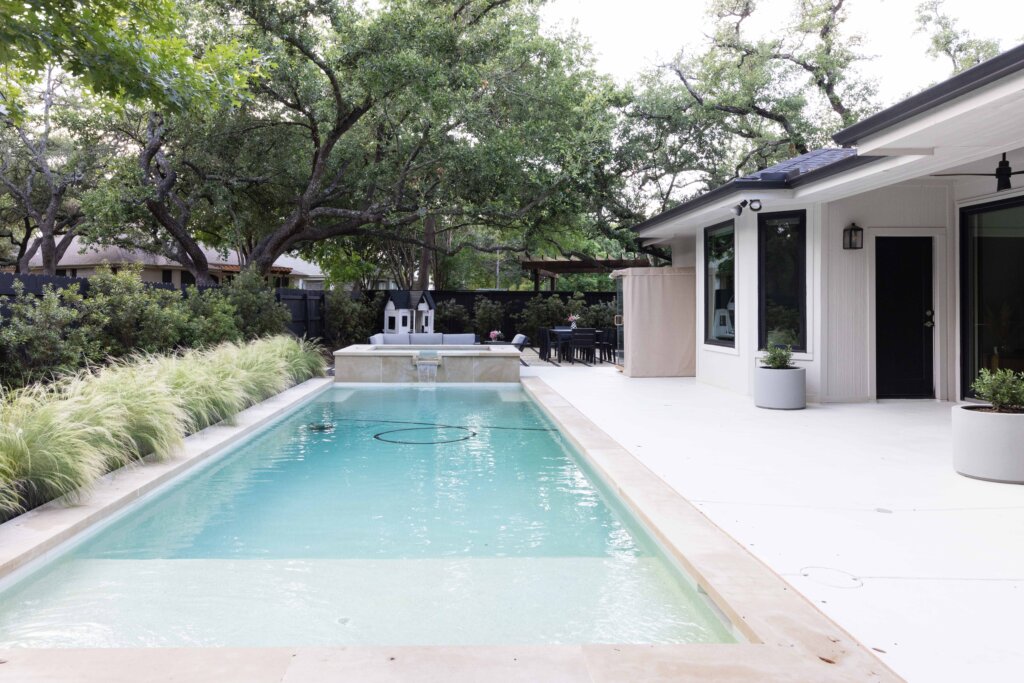
Our Favorite No-Grass Front Yard Ideas

